Archive for the ‘Threats from Government Funding Neglect’ Category
Thursday, August 18th, 2022
We have stumbled across another old local government plan for The Gully, adding to The Gully Collection of The Habitat Advocate.
This one dates back to 1980 in brief draft form and was published in 1981 by landholder Blue Mountains {city} Council (local council). We only have the first eight pages of the 1980 draft, but we have the entire 53-page document of the 1981 ‘Frank Walford Park – Plan of Management‘.
We are also aware of prior land use plans for this valley extending back after WWII in the mid-1950s to impose the racing car circuit; and even back to the 1870s, when the first private colonial landholder of the area, John Britty North, subdivided a ridgetop portion for the first tranch of profiteering housing development. Befitting his robber baron ego, North dubbed it ‘North’s Estate’.
We at The Habitat Advocate are actually situated on the old North’s Estate since 2001, as our later reasearch tought us. We chose to live here because it was old established residential and so not to cause more deforestation by buying a finge ‘bush block’. So we research this area where we live in order to better understand its history, stories and so to better appreciate its conservation values.
We embed on this webpage below the draft document extract entitled ‘Assessment of Frank Walford Park Katoomba – Land Suitability, Environmental Constraints, Management‘. It appears to be hand typed, in the days before computers.
We also embed below the subsequent ‘Frank Walford Park – Plan of Management‘ of 1981 by local council. Both documents are supplied in PDF format and are made available here to the public for printing and downloading. Both the draft extract and the final plan of management relate to what was/remains ‘community land’, so we have no qualms in reproducing them here and making them freely publicly available.
Both documents are instructive in that they prescribe land use planning for what is currently termed ‘The Gully’ (or ‘Gungaree’ in native Gundungurra) that have subsequently been reguritated by council with many reiterations and renamings ever since. Consistently, as has been local council’s form similarly for decades, that is solely about being seen to comply with New South Wales Government’s mandatory planning laws for community lands.
Yet equally consistently, local council has serial form in implementing little if any on-ground action in this creeek valley. Why? Simply because of the lack of political/bureacratic will, and council’s decided to not even apply for external funding to have any of its plans of management for rehabilitating ‘The Gully’ implemented – since its 1972 demise of the racetrack. It’s a classic case of persistent organisation cultural guilt that continues to be seeded across subsequent generations of politically swayed bureaucratic management and incoming councillors decade after decade. Council’s cultural hate toward The Gully is despicable.
The contents focuses on the natural environmental features of the then ‘Park’, its historical and existing (human) uses, proposed land uses and a management plan.
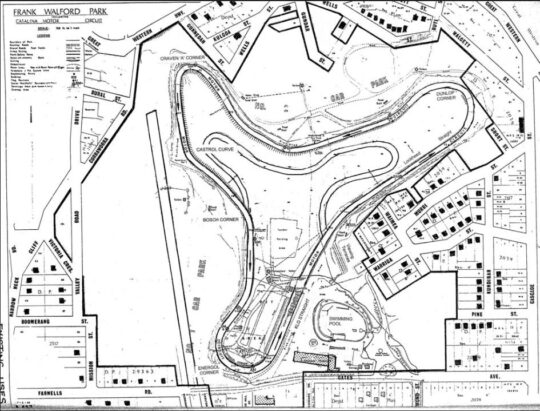 Frank Walford Park – Catalina Motor Circuit Map (circa 1980) showing the symetrical three-leafed shamrock shapped loop 1.3 miles in length. [SOURCE: Frank Walfors Park Managament Plan 1981, Blue Mountains {city} Council].
The above included street map shows hand written existing uses of the Park as approved by Council (utilising a good magnifying glass):
- Catalina Motor Racing Circuit
- Rally Cross Circuit (inside the circuit)
- BMX Track (inside the circuit)
- Three car parks (2 for spectators, 1 for competitors’ cars)
- Pit Area (inside the circuit)
- Four food stalls (outside the circuit) including the Apex Club food stall (top left)
- Three toilet blocks for spectators (outside the circuit)
- One toilet blocks for spectators (outside the circuit)
- One shower block for competitors (outside the circuit)
- Catalina Lake (for swimming)
- Indoor Recreation Centre (Council’s)
- Swimming Complex (outdoor pool)
- Bushfiire Shed (Rural Fire Service)
- An archery field
So at the time, the predominant appproach by Council to the use of the Park was for recreational and tourism use, less so environmental conservation and ecological rehabilitation.
 Note that the aforementioned ‘Apex Club food stall‘ at the motor racing circuit reveals key connection with the then Council Mayor Frank Walford. In 1956 Frank with his wife Madge were guests of honour at this fundraising Apex District Convention held at the then Katoomba Town Hall on nearby Parke Street situated on the ridgetop overlooking Frank Walford Park. Frank and Madge Walford are seen sitting at the head table (top left in this photo). [SOURCE: Blue Mountains Library – Local Studies, copyright licensing: Attribution, share alike, creative commons].
Frank Walford Park Management Plan of 1981
After Blue Mountains Mayor Frank Walford [1882-1969] passed away at age 80 years, Blue Mountains {city} councillors decided to name the creek valley after him as Frank Walford Park, probably sometime during the 1970s. Frank Walford had been a key supporter on council that approved a motor racing circuit to be constructed from 1957 in this small amphitheatre-shaped creek valley on the western fringe of the township of Katoomba.
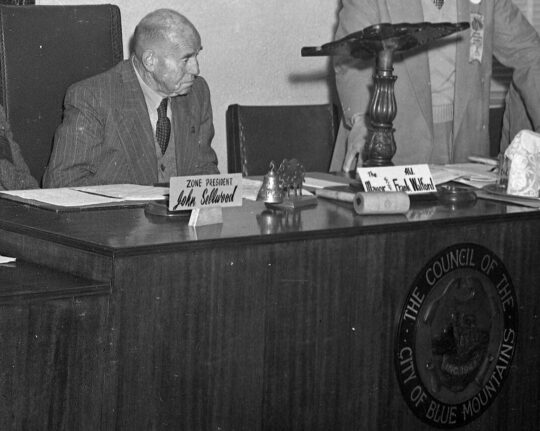 Mayor Frank Walford in 1956 (then aged 76) at a council meeting in the old Town Hall situated in Parke Street on the ridgetop just above the creek valley. The Town Hall was demolished in the 1960s and not replaced. Instead councillors voted to build a brutalist monolithic Council Chambers highrise building at a site isolated from the Katoomba business community.
Local residents who had lived in this small creek valley before 1957 had affectionately referred to it as ‘The Gully’. Council as the landowner of the valley, forcibly evicted all the local residents between 1957 and 1959, which involved council sending in a bulldozer to raze all their homes in order to make way for the new racetrack for a group fo locally influential and wealthy businessmen who were avid sportscar racing enthusiasts. Dubbed ‘Catalina Racetrack’ by council, the track operated between 1961 and 1971, after which the organisation running it went bankrupt.
By 1980, New South Wales Government planning laws required local councils throughout the state of New South Wales to periodically produce appropriate land use plans of management for community lands under their control, such as in the case of locl council, Frank Walford Park.
The draft extract of the 1980 plan would seem for the first time to start respecting the environmental values of this creek valley portion referred to by local council as Frank Walford Park. Local council’s draft assessment of Frank Walford Park is divided into two sections:
- Section 1: Reviewing the existing landscape, natural features, persent land use and historcial uses and :
- Section 2: Proposed land use development options
Wednesday, August 3rd, 2022
Sometime back in early 2022, Blue Mountains {city} Council, in its insular ‘ivory tower’ bureaucratic wisdom, reckoned that wasting thousands of grant funding from the NSW Government on a so-called sandstone ‘yarning circle‘ for The Gully in Katoomba would be a public relations hoot!
Council’s yarning circle site was strategically chosen for maximum PR exposure for visitors to The Gully, just by the lake off Madge Walford Fountain carpark, just off Gates Avenue in Katoomba. Sure enough, the project, completed in February 2022, found its way to a press release in the local newspaper, the Blue Mountains Gazette, on 20th April 2022 entitled ‘Transforming The Gully’.
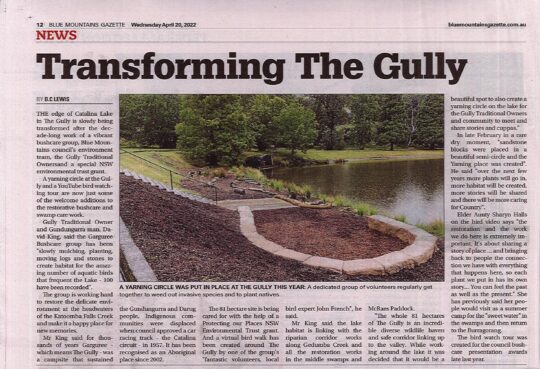 Council’s press release in the local Blue Mountains Gazette newspaper on page 12, dated 20th April 2022.
This press release states that this new stone yarning circle on..
“the edge of Catalina Lake in The Gully is slowly being transformed after the decade-long work of a vibrant bushcare group, Blue Mountains council’s environment team, the Gully Traditional Owners and a special NSW environmental trust grant…. a yarning circle at the Gully and a YouTube bird watching tour are now just some of the welcome additions to the restorative Bushcare and Swampcare work.”
A stone yarning circle being part of restorative bushcare? Seriously?
Council previously had approved three similar stone circles nearby in The Gully back in 2008. That’s where an external grant of some $600,000 went – on an Aboriginal-only interpretative history path.
Sure, the dedicated group of volunteers of Garguree Swampcare Group who frequently convene in The Gully to weed out invasive plant species and plant out locally native plants do certainly effect restorative bushcare. The group formed a decade ago back in 2011 under the New South Wales Government’s Landcare NSW umbrella (not Council’s). As a local, the regenerative on-ground results of this volunteer group’s Swampcare efforts are readily observed by one walking around The Gully, especially noted inside the Dunlop Corner section of the old racetrack with the removal of all the blackberry and cotoneaster and the landscaping and planting out our of locally native plants and trees.
Former members of ‘The Friends’ would be well pleased that the native habitat restoration in this creek valley has continued since 2011. Yet sadly, no mention is made of the 27+ years of the Friends of Katoomba Falls Creek Valley Bushcare Group [1989 – 2016] and their related subgroups who continue to work in adjacent McRae’s Paddock and Selby Reserve, contributing many thousands of volunteer hours weeding The Gully of invasive plant species. Let the truth be told.
The Habitat Advocate has been based in The Gully Water Catchment since 2001 and over the two decades we have become very familiar with this rather special creek valley. Our editor walks around it weekly for exercise and peace of mind in Nature, not just the old racetrack, but south from the aquatic centre through MacRaes Paddock, Selby Reserve and to Katoomba Falls. He observes the goings on – the creek health, the landslips, continuing off-leash dog walkers, and the incremental new housing replacing the bushland along Wellington Street, etc.
Council’s press release states that the group’s volunteer co-ordinator David King (being a son of a former Gully resident) has been..“slowly mulching, planting, moving logs and stones to create habitat for the amazing number of aquatic birds that frequent the Lake – 100 have been recorded..The group is working hard to restore the delicate environment at the headwaters of the Katoomba Falls Creek and make it a happy place for new memories.”
The Habitat Advocate supports David King’s Swampcare leadership, wholeheartedly.
Council’s press release goes on…
‘Mr King said for thousands of years Garguree – which means The Gully – was a campsite that sustained the Gundungurra and Darug people. Indigenous communities were displaced when council approved a car racing track – the Catalina circuit – in 1957. It has been recognised as an Aboriginal place since 2002.
The 81 hectare site* is being cared for with the help of a Protecting our Places NSW Environmental Trust grant…Mr King said the lake habitat is linking with the riparian corridor works along Gedumba (sic) Creek and all the restoration works in the middle swamps and McRaes Paddock. The whole 81 hectares of The Gully is an incredible diverse wildlife haven and safe corridor linking up to the valley. While working around the lake it was decided that it would be a beautiful spot to also create a yarning circle on the lake for the Gully Traditional Owners and community to meet and share stories and cuppas.”
Garguree Swampcare has previously won the prestigious regional Indigenous Land Management Landcare Award in 2017.’
[* Editor: “81-hectare site?”
The Gully Water Catchment covers 290 hectares/2.9 km2 Dr Fred Ball’s 1993 Plan. So, Mr King’s 81 hectares represents a tiny 28% remnant of the creek valley’s water catchment area. However in fact, Blue Mountains {city} Council’s 2021 Plan at page 17 states the land area is 73.1 hectares as per the extract below, not 81 hectares; that is, unless Council’s doing another sneaky ursurp of its zoned community lands?…]
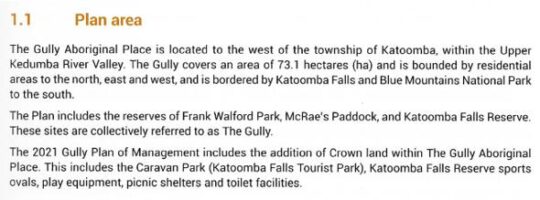 SOURCE: ‘The Gully Aboriginal Place of Management’, 2021-10-04, Section 1.1 Plan Area, page 17, by Blue Mountains {city} Council, with input by The Gully Traditional Owners, and funded by the NSW Government.
Again, The Habitat Advocate supports this habitat restoration endeavours wholeheartedly. But the timing of Council’s yarning circle is apposite. It took place during the period between July 2018 and October 2021 when Council was undertaking a revision of its 2004 Plan of Management for The Gully Aboriginal Place. Yet in both Council’s 2004 plan and subsequent 2021 plan, ‘yarning circles’ were not suggested, discussed, featured, nor budgeted for.
Instead, Council’s latest ‘yarning circle’ in The Gully seems to be some unplanned whim from grant funding undisclosed and outside any of the now 19 plans for and reports on The Gully. Maybe it was some bureaucrat’s whim within council with connections to the Parks Service to utilise excess stone blocks over-ordered for heli-upgrading of nearby hiking tracks in the national park. Voilà, another Council stone yarning circle crops up!
Anyway, so today we checked out this Council’s yarning circle down by the old artificial dam; a ten minute walk each way and took a few photos of it. Currently in the depth of winter, sitting on these fifteen cold hard sandstone blocks for too long would likely bring on a bout of haemorrhoids, so wise to bring a rug or two. The following photo was taken from the steps leading down to the lake, which originally provided the main access for swimming in the 1940s and 1950s before Council built its aquatic centre. Note the old changing sheds in the background.
 Council’s transforming urbane vision in February 2022: It’s priority ‘yarning circle’ due to be just as another unused white elephant like Council’s $6 million concrete amphitheatre installed at Echo Point in 2019, save for PR media releases. [Photo by Editor, 2022-08-03]
Now this new ‘yarning circle’ is situated right by existing picnic tables on the lawn area behind next to the old racetrack and these serve to provide quite adequate seating for picnicking and if you like, some yarning. So it is an extraneous folly indeed.
For some reason Council in its wisdom, also recently decided to remove the only rubbish bin on this side of the lake.
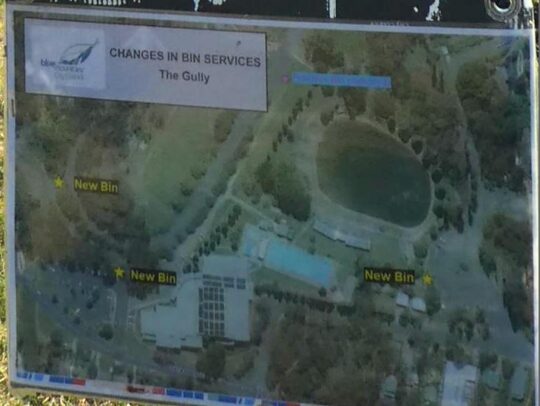 Council’s notice on the old racetrack near the lake
This is possibly because there is no Council ranger assigned to empty it. Instead there is a bin at the Madge Walford Fountain carpark side of the lake, and two of Council’s aquatic centre car park, meaning Council’s ranger now doesn’t have to walk far from his/her car to empty them – must be to do with OH&S walking.
Speaking of safety, the site of this yarning circle is just metres down slope from a small freshwater spring that causes the grass in the vicinity to be constantly boggy. The site was originally a sedge swamp within the original natural riparian zone of the central creek; that is, before the artificial lake was constructed. The problem is that constant ground water seepage drains around and down the only steps leading to this new yarning circle below.
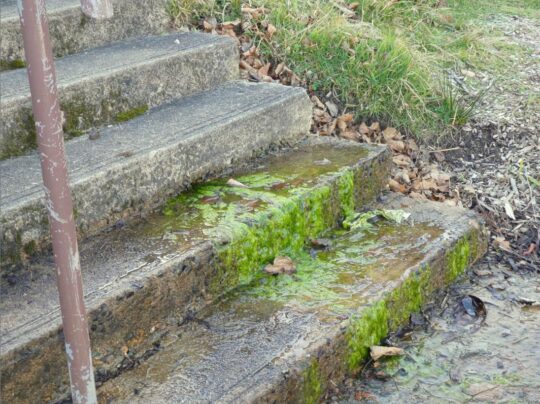 Concrete steps down to Council’s new stone yarning circle #4: Perennial spring ground water here causes moss to grow on the only downward step approach to the yarning circle, so creating a public trip hazard. Council is known to manage occasional grant funding for PR purposes, but has form in neglecting regular maintenance. May be the contractor for the yarning circle on the day responsibly swept away the moss; alas only to return. Council has no interest in The Gully besides its mandatory legal compliance, timely PR on occasion for the local rag and its glossy brochures despatched to ratepayers with their rate notices.
This is simply local knowledge by those like The Habitat Advocate who know this creek valley intimately. But Council in its ivory tower mindset constantly chooses not to consult with locals knowledge about its actions in The Gully. Yes, Council must first legally consult with The Gully Traditional Owners (GTO) as custodians of The Gully Aboriginal Place, yet despite none living within ‘Cooee!‘ of The Gully.
But the GTO would not have designed this folly and not at this location. When the interpretative walking pathway was designed, a primary feature was to enable disabled access so the pathway and boardwalks were all pre-designed to facilitate wheelchair access throughout.
 The Gully’s interpretative pathway is wheelchair friendly so that it is accessible to anyone with a physical disability and mindful of the former residents (pre-1959) who are elderly to access this pathway – such a thoughtful design gesture. But the funding did not come from Council’s Environmental Levy as the now deteriorated sign to the right claims. It cam from a NSW Government Grant of $600,000 in 2008.
Key problem with this Interpretation Pathway biasely tell an Aboriginal-only story, not the true account about dispossessed poor folk who were Black and White and mixed. Council funded any of it, rather all the funding was external – NSW Government and Rous Water in the Northern Rivers region. Council did not seek or obtain a development application. Council did not seek or obtain any local community consultation, but only from the Gully Traditional Owners who were by 2008 usurping control in all decision making of The Gully to the deliberate exclusion of all other locals. Council deliberately and hatefully ostracised The Friends of Katoomba Falls Creel Valley Inc., who had undertaken considerable bushcare rehabilitation and lobbied Council since 1989 to protect this creek.
Council did not seek or obtain a development application. Council received no official clearance. It just thought it up and did it.
Sound familiar?
Apocalypse Now quote:
“Kurtz staged Operation Archangel with combined local forces, rated a major success.
He received no official clearance. He just thought it up and did it.
What balls.
They were gonna nail his ass to the floorboards for that one.
But after the press got a hold of it, they promoted him to full colonel instead.
Oh, man, the bullshit piled up so fast in Vietnam, you needed wings to stay above it.”
^https://movie-sounds.org/war-movie-sound-clips/quotes-with-sound-clips-from-apocalypse-now/he-received-no-official-clearance-he-just-thought-it-up-and-did-it
Former residents of The Gully (pre 1957-59) are elderly and many are observed by this author as being physically disabled, having attended a number of invited gatherings with former residents in The Gully. This points to this ‘yarning circle’ down by the lake, accessible by only by the steps, as being is a Council thing and likely contrived by some person without knowledge in perhaps Council’s PR department or by another one of Council’s external consultants driven in from distant Sydney.
Since at least 1981, a whole series of plans and reports to local Blue Mountains {city} Council on this creek valley have prescribed many environmental rehabilitation actions to be undertaken throughout. However precious little has been done by council as the custodial land manager. For instance, the ‘Bell Report’ of 1993 (plan #8) to Council on this creek valley in its executive summary on pages 6 and 7 identifies some sixty recommended actions for this creek valley of varying priorities as part of a prescribed environmental management plan. [Read More]. Had Council acted upon these recommendations then the Gully would have been truly transformed back to approximating its original ecological landscape and health as it was before the colonising usurpation since perhaps the mid-1800s.
Neither the Bell Report nor any of the 19 plans/reports (at least) on this creek valley include any ‘yarning circle’ nor ‘stone circle’, nor even a ‘crop circle’.
 Council holds a condescending penchant for installing ‘yarning circle ‘follies for Aboriginal use, with now three in The Gully and one at Echo Point. So where’s this nutty motivation coming from?
Blue Mountains {city} Council has already approved three other such stone block gathering places or ‘yarning circles’ in The Gully. These were part of its approval in 2008 for an Aboriginal interpretative meandering pathway concreted inside its terminated Catalina Park motor racing circuit. It serves to showcase the history of prior Aboriginal residents of The Gully – which Council forcibly evicted between 1957 and 1959 for its motor racing mates.
Evidential of the truth, Council’s meeting minutes recorded this back in 1959:
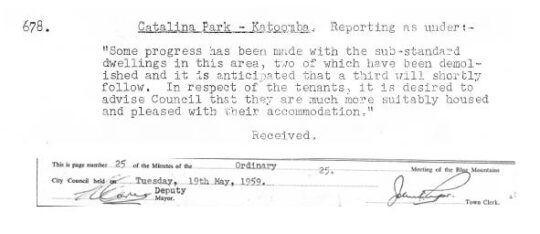 Truth telling
So why the need for a fourth stone circle in The Gully? And why position it adjacent to an invasive dam that was built by non-Aboriginal people over the top of the pre-existing riparian zone of the creek?
Here we show Council’s other three ‘stone circles’ in The Gully.
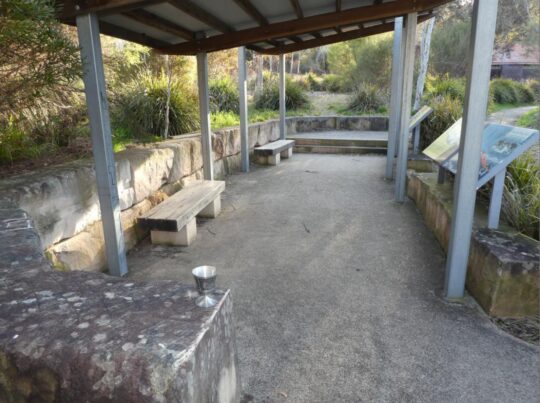 Stone Yarning Circle #1 – Notice how blackened the sandstone has become over time to moisture attracting mould in the wet pervious sandstone after 14 years and the lack of Council maintenance. Not exactly an aesthetically welcome look now
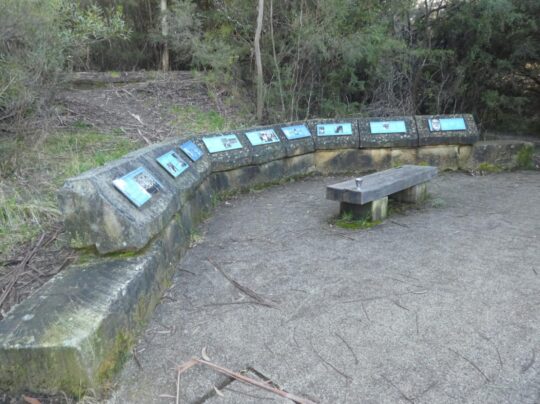 Stone Yarning Circle #2. Actually this is the site where in 2001 Council provided dump truck access so the RTA could dump hundreds of tonnes of sand and rock fill on top of The Gully sedge swamp from its highway cutting at the Soldiers Pinch bypass excavation project near Mount Victoria. More black mould neglected by Council.
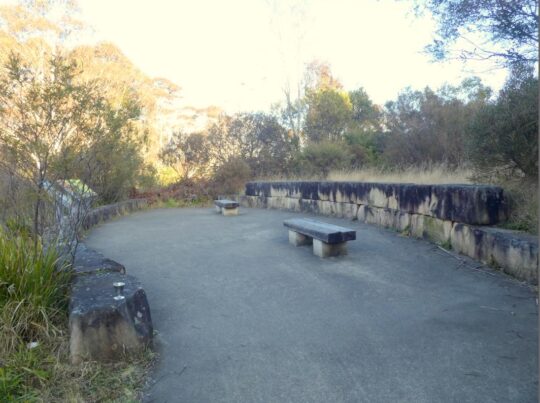 Stone Yarning Circle #3. More black mould neglected by Council. We predict Council’s latest fourth yarning circle will similarly deteriorate in a few years time due to its record of ignoring maintenance.
The invasive non-Aboriginal history of this creek valley
Council’s stone ‘yarning circle’ is artificial just like the artificial lake adjacent. It is pure aesthetics and seems to be a public relations ploy by Council to showcase: “Look, Council is actually doing something constructive in The Gully!”
But Council’s latest haemorrhoid yarning circle achieves precious little in rehabilitating the riparian zone habitat of this decades-long neglected and abused creek valley.
For starters, the lake adjacent is actually a dam that was constructed post-WWII over the top of the old ‘Frogs Hollow’ spring/swamp riparian area of Katoomba Falls Creek by local tourist entrepreneur at the time, one Horace Gates. It was part of his grand scheme to impose a carnival amusement park called ‘Catalina Park’ in the valley.. offering ‘every facility for fun and food’.
Horrie in 1948 seconded the shell of an old Catalina PBY-5 flying boat for his new dam as a unique tourist attraction to his amusement park. By 1949 he arranged for local council to supply 100,000 gallons of water for it, metered at 1/6d. per thousand litres. [Council of the Blue Mountains meeting minute :’Supply of Water to H. Gates for Catalina Park’, dated 11th January 1949, 7 pm, page 3.]
Horrie also paid £500 towards the £2,500 cost of constructing new Plantation Street westward between Cascade Street and his Catalina Park that same year. [Council of the Blue Mountains meeting minute :’Plantation Street: Katoomba’, dated 15th February 1949, 7:30 pm, page 183.]
Horries’ new ‘Catalina Park’ subsequently served to provide various attractions and activitioes including speedboat rides, tearooms, miniature train, a Ferris wheel, merry-go-round, swimming pool and a Giggle House showing Charlie Chaplin films.
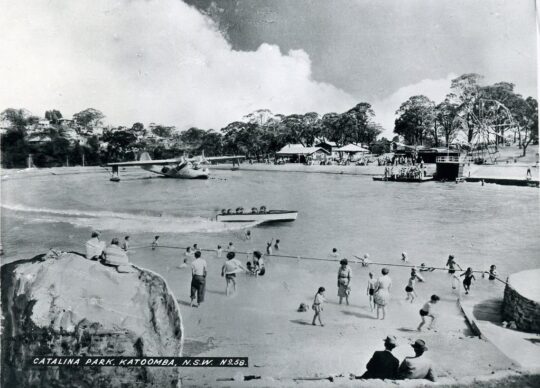 Horace Gates’ Catalina Park circa 1950. This was during summer of course, since the water temperature can get down to 4o degrees celsius in winter months. The concrete steps to the now stone ‘yarning circle’ would be off picture to the right.
Horrie also locally owned an amusement parlour on the north-west corner of Katoomba and Waratah Streets, as well as his ‘Homesdale Guesthouse‘ at 207 Katoomba Street including its Wentworth Cabaret nightspot downstairs. Subsequently the guesthouse was replaced to become the much larger Katoomba Corps branch of the Salvation Army, then in 2021 it was converted into backpacker accommodation of international Youth Hostels Association (YHA).
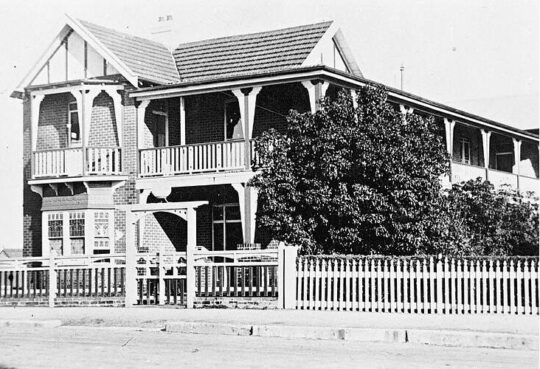 Homesdale Guesthouse in the 1920s. Horrie wasn’t exactly short of a few bob and had influence on Council to acquire the portion of The Gully he named Catalina Park in the post-war 1940s.
Katoomba tourism was Horrie’s thing 1920s into the 1950s. He was a relatively successful entrepreneurial businessman of Katoomba. But he used his wealth to be one of the many usurpers of The Gully.
But Horrie cared not for the welfare or quite enjoyment of the adjacent residents of The Gully. They were mostly Aboriginal impoverished families subsisting in meagre self-made shacks in the bush with no utilities – having no running water, no electricity, no gas, may be septic tanks pre-1907. Thereafter Council imposed town sewage be trenched throughout the creek valley, yet not connected to any of the Gully shacks (councillors didn’t want to encourage what they regarded as a shanty bush settlement on the edge of town).
A walking visit to The Gully these days reveals interpretative signage record of the simple subsistence living conditions that former residents endured before Council’s forced evictions and calling in the bulldozers 1957-1959.
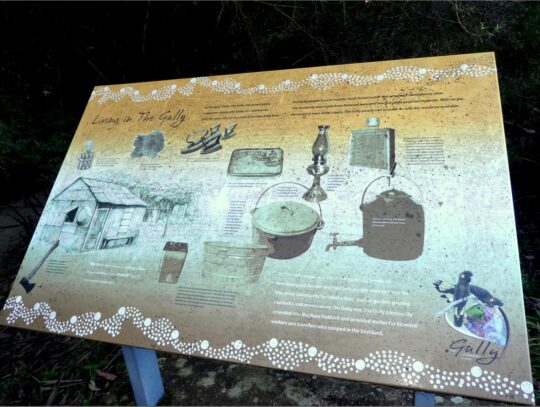 Living in The Gully was basic bush camping
May be there was one toilet block for the entire Gully if they were lucky. May be that tiny brick one below Wells Street, or was it a more recent addition for overnighting campers attending motor race meets later in the 1960s and 1970s?
By the early-1950s, Catalina Park as then an amusement park was pretty dated and run down. When Horrie died, Council named Plantation Street adjacent as ‘Gates Avenue’ and Horrie’s dam as ‘Catalina Lake’. Council in the 2000’s renamed a nearby short portion of Farnells Road as ‘Catalina Avenue’ as an appeasement gesture to the petrol-head fraternity bemoaning Council’s 2002 closure of their Catalina Park motor racing circuit just by the lake.
This use of The Gully was all entirely non-Aboriginal use and exploitation by wealthy outsiders – the amusement park (1946-1950s) followed by the raceway (1957-2001). So the pertinent question in relation to this fourth stone yarning circle by Council is why spend money complementing an unnatural part of The Gully. This is just another whim, indeed a folly.
Who’s idea was it? How much did it cost? Why did this civil works project take priority over many other priority ecological rehabilitation actions in the valley as prescribed by many plans of management since at least 1981? Surely, given the latest Plan of Management of October 2021, the use of that “special NSW environmental trust grant” as quoted in the newspaper article, should have applied to the action items listed in that plan. The 2021 plan lists a mere 6 action items on page 111. , just 10% of the 1993 plan.
In comparison to the 1993 plan of management’s 60 recommended action items, Council’s 2021 plan list a mere 6 ‘governance actions’ on page 111 budgeted to cost $54,950. How much did this fourth stone yarning circle project cost? On page 113 indicates a massive budget of $4,742,910 to implement the latest plan of management. But this list is not about habitat restoration of The Gully, its all about human usage as the following cost summary reveals:
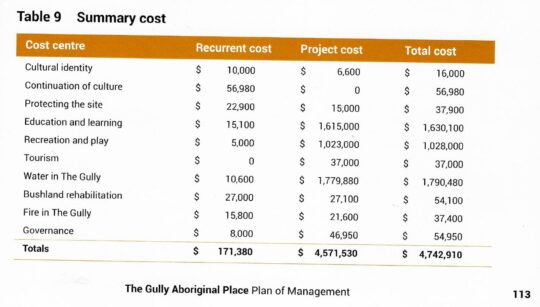 Truth telling: The Gully Aboriginal Place 2021 Plan of Management
Council’s 2021 plan includes a pie-in-the-sky budget totalling a massive $4,742,910. Co-incidentally Council’s 2004 plan budgeted a similar $4,682,000. Didn’t happen.
Council’s 1996 (Connell Wagner) Plan listed many distinct habitat restoration focuses and action plans for each portion of the creek valley, then respectively named Frank Walford Park, McRaes Paddock, Katoomba Park, and included Katoomba Golf Course. Featured in all four portions included regenerating of re-vegetation degraded areas and rehabilitating swamps and bushland. Budgeted total costs came in at $794,500.
Didn’t happen.
Council’s 2021 plan won’t happen. This latest plan is set to be mothballed by Council again, because like the 18 previous reports and plans on this riparian valley, the 2021 plan contains the usual escape clause to allow Council to do again nothing in The Gully. A funding excuse. Council is legally compelled by the New South Wales Government to prepare a plan of management for a public (community) land it controls/owns such as The Gully, but Council in its history is yet to seek the requisite budgeted external funding for any plan for The Gully in order to complete the recommended action items.
May we suggest to the insular thought bubble that is Blue Mountains {city} Council that rather than it have imposed a 4th Celtic yarning circle in The Gully for the rarely seen Aboriginal folk around, that Council instead focus its cash on more pressing public safety measures in and around The Gully?
Below is one such pressing public safety problem deserving Council’s prompt maintenance.
It’s possibly the largest pothole currently besetting the Blue Mountains at some 4×2 metres in size!
It’s situated down the very steep road of Warriga Street on the eastern approach to The Gully. Such being the months of this pothole’s deterioration, one almost needs 4×4 vehicle to currently negotiate through it!
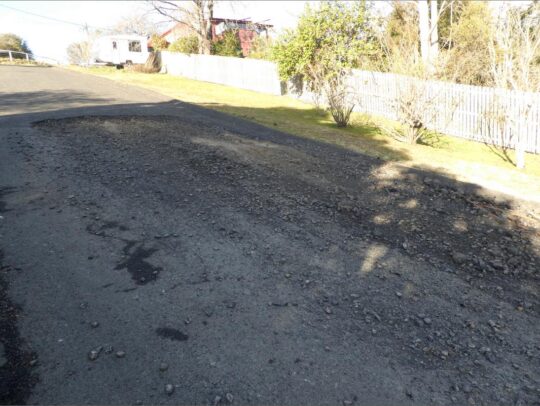
Further Reading:
[1] Garguree Swampcare Group, ^https://garguree.bushcarebluemountains.org.au/
[2] Catalina Park (motor racing circuit 1961-2001), ^ https://www.racingcircuits.info/australasia/australia/catalina-park.html
[3] ( Photos of Catalina Park), Blue Mountains Library, ^ https://www.flickr.com/photos/blue_mountains_library_-_local_studies/2627033062/in/photostream/ | ^https://www.flickr.com/photos/blue_mountains_library_-_local_studies/2493550745
[4] Catalina Park (amusement park 1946-1950s), Blue Mountains Local Studies, ^ https://bmlocalstudies.blogspot.com/2010/06/catalina-park-katoomba.html
Saturday, November 15th, 2014
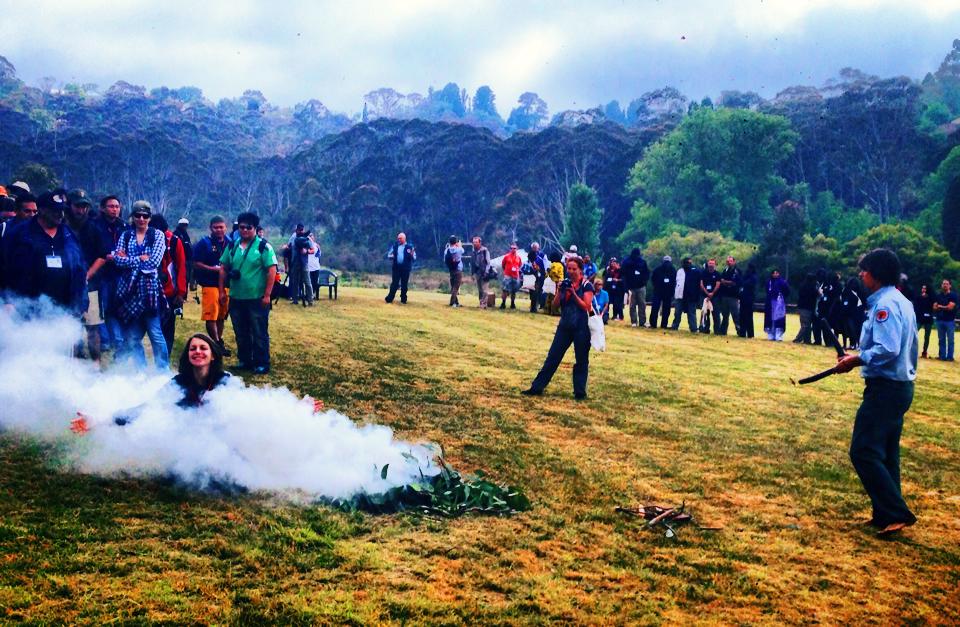 Smoking Ceremony or Smoke and Mirrors?
Staged for the delegates by National Parks and Wildlife Service of New South Wales (NPWS), somewhere outside Sydney, Australia
[Source: ‘Global First Nations environmentalists share stories at the World Parks Congress in Sydney.5:30’, ^https://twitter.com/nitvnews, 20141113] Smoking Ceremony or Smoke and Mirrors?
Staged for the delegates by National Parks and Wildlife Service of New South Wales (NPWS), somewhere outside Sydney, Australia
[Source: ‘Global First Nations environmentalists share stories at the World Parks Congress in Sydney.5:30’, ^https://twitter.com/nitvnews, 20141113]
.
Every ten years a World Parks Congress is a forum staged by the International Union for Conservation of Nature to discuss the effectiveness of World Heritage Listed Protected Areas. For 2014, Parks Australia put up Sydney’s hand to host and fund it.
<<“We (Parks Australia) are delighted to be co-hosting the IUCN World Parks Congress with our colleagues in the New South Wales National Parks and Wildlife Service – and look forward to welcoming inspiring leaders from around the world.”>>
IUCN’s vision is a “just world that values and conserves nature.” The theme for the 2014 conference is “Parks, people, planet: inspiring solutions”.
The last congress was in Durban, South Africa eleven years ago in 2003 and significant messages from that congress were that:
- Considerable progress has been made in the establishment of protected areas although significant gaps remain
- Protected areas face many challenges, and management effectiveness must be strengthened
- Protected areas play a vital role in biodiversity conservation and sustainable development
- A new deal is needed for protected areas, local communities and indigenous peoples
- There is a need to apply new and innovative approaches for protected areas, linked to broader agendas
- Protected areas require a significant boost in financial investment
- Protected areas management must involve young people
.
Congress Cost Benefits ?
.
The obvious first question for the 2014 Sydney Congress is what are the outcomes from these seven messages of 2003?
The second question is what is to be the conservation return on investment of staging the 2014 congress in Sydney? That starts with Parks Australia and NPWS disclosing the full costs of the congress. How much will it have cost by the time this week is over? Five million? Ten million? Twenty million? More? That also involves disclosure of the onground conservation outcomes, if any. The congress hosts more than 5000 delegates for a week-long event in Sydney.
If the answers are not forthcoming and/or the performances less than satisfactory, then perhaps the money could have been better spent (invested) by Parks Australia and NPWS on specific onground conservation of current and worthy Protected Areas in Australia. So the third question is what is the opportunity cost of the 2014 IUCN World Parks Congress which could have delivered the IUCN vision of a “just world that values and conserves nature”?
.
Congress Opportunity Costs
.
According to IUCN director general, Julia Marton-Lefevre, assessments during the past decade have found that half of the world’s protected areas at best — and possibly as few as 20 per cent — are managed effectively. “Some are what we refer to as ‘paper parks’ ” – parks just on paper.
The Australian Government’s $180 million allocation to expand the park reserve system expired last year.
The Great Barrier Reef Marine Park is a case in point. It is the iconic Protected Area in Australia. Its World Heritage listing along with various national zoning, management plans, permits, education and incentives are supposed to protect and conserve the marine ecosystems and migratory species from human threats. But farm and urban runoff continues to contaminate the rivers that flow into the Reef.
In 2009 and 2011, mining company Queensland Nickel discharged nitrogen-laden water and 516 tonnes of toxic waste water into the Great Barrier Reef.
On 21 July 2013, on the second day of the biennial joint training exercise Talisman Saber, two American AV-8B Harrier fighter jets launched from aircraft carrier USS Bonhomme Richard (LHD-6) dropped four bombs, weighing a total 1.8 metric tons (4,000 pounds), into more than 50 metres (164 ft) of water. On 3rd April 2010, The Shen Neng 1, a Chinese ship carrying 950 tonnes of oil, ran aground, causing the 2010 Great Barrier Reef oil spill.
In December 2013, Greg Hunt, the Australian environment minister, approved a plan for dredging to create three shipping terminals as part of the expansion of an existing coal port. According to corresponding approval documents, the process will create around 3 million cubic metres of dredged seabed that will be dumped within the Great Barrier Reef Marine Park.
On 31 January 2014, a permit was issued to allow three million cubic metres of sea bed from Abbot Point, north of Bowen, to be transported and unloaded in the waters of the Great Barrier Reef Marine Park, just outside of Abbot Bay. The dredge spoil will cloud the water and block sunlight, thereby starving sea grass and coral up to distances of 80 km away from the point of origin due to the actions of wind and currents. The dredge spoil will smother reef or sea grass to death, while storms can repeatedly resuspend these particles so that the harm caused is ongoing; secondly, disturbed sea floor can release toxic substances into the Great Barrier Reef Marine Park.
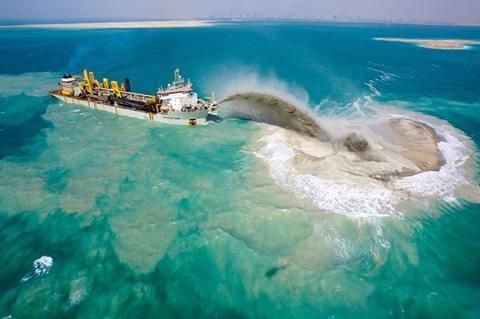 Dredging the Great Barrier Reef for bulk export shipping Dredging the Great Barrier Reef for bulk export shipping
.
The Great Barrier Reef Marine Park has become just a blue line on a map. The trickle of funds for Australia’s national parks betrays a lack of appreciation of their economic contribution. Annual funding for the authority that runs Australia’s most famous reserve, the Great Barrier Reef Marine Park, is about 1 per cent of the $5.2bn it earns the country in tourism revenue.
Yet if the IUCN World Parks Congress cost a conservative $20 million to stage then a key opportunity cost would be the June 2014 Federal budget cuts to the Great Barrier Reef Marine Park Authority.
The budget axed 17 staff including five of its’ directors positions. These positions included the director of heritage conservation, the director of policy and governance and the director of coastal ecosystems and water quality as part of an internal restructure. It’s being described as the greatest loss of expertise from Australia’s most important natural wonder and it comes at the very time the Great Barrier Reef is facing the greatest threat to its survival.
The Greater Barrier Reef Marine Park Authority has been reduced by the Australian Government to being in name only and ineffective at protecting the reef.
Until recently, one of those five directors, Adam Smith, was charged with dealing with the contentious Abbot Point coal terminal development and the proposal to dump three million cubic metres of dredge spoil into the marine park. Despite Dr Smith’s concerns, the sea dumping was approved by the Marine Park Authority.
Dr Smith has since accepted voluntary redundancy and moved on after disagreeing with the Authority’s new economic leadership and values. Heritage conservation director Jon Day has left after 21 years, disillusioned too with the direction the Authority has taken to compromise the reef.
Next year UNESCO will decide whether to put the reef on its world heritage in danger list. Native Dugongs are already endangered. The deliberate extermination of the dugong and turtles which habituated the Gladstone area is a national tragedy. Dugongs are species listed under the Federal Environment Protection Biodiversity & Conservation Act, which requires the Federal government to legally protect these animals.
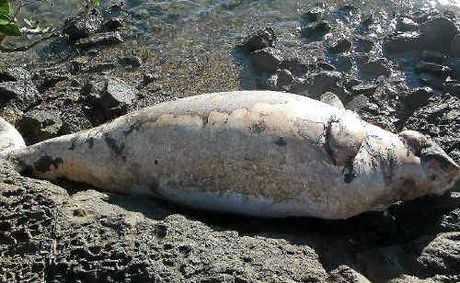
Prior to the massive dredging operation of 52 million cubic metres of seabed for the development of the world’s largest LNG Terminal, ( which is 62% completed) a study commissioned by the Gladstone Ports Corporation found that a take, or a quota, of more than zero dugongs would be unsustainable.
In the face of massive mortality of dugongs, turtles and inshore dolphins during the ongoing massive dredging, both the Federal and Queensland governments ignored the slaughter.
Look at the stranding data from the Queensland Department of Environment and Resource Management. Monthly cumulative Dugong strandings by year for Queensland, up to 31 January 2012.
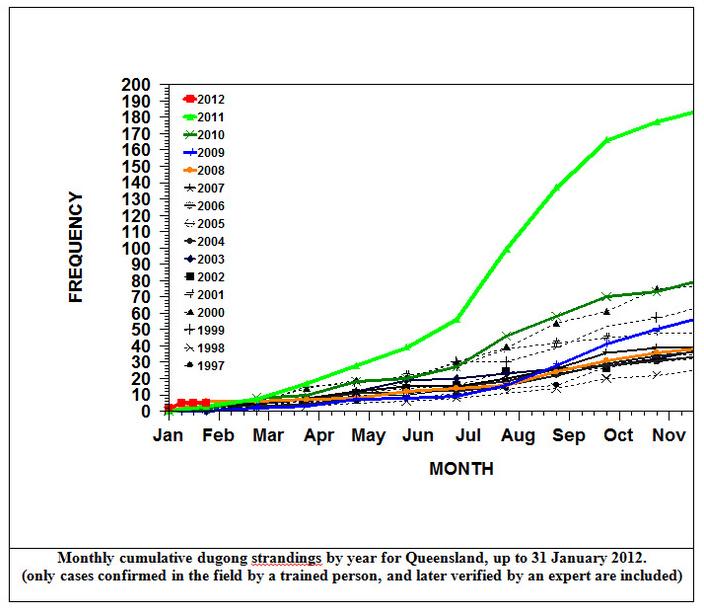
There are 22,000 vessel movements a month in Gladstone Harbour. No ship strikes of Dugongs or of Green Turtles need to be reported. No audit of environmental conditions has been undertaken by the Queensland or Federal Governments. The wholesale slaughter of our marine wildlife is the price Australians are paying for the transformation of the Great Barrier Reef World Heritage Area into the world’s largest unregulated quarry.
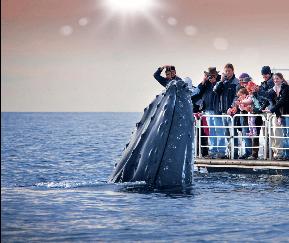 Mass tourism operators good for the economy
Getting up close to protected Humpback Whales within their 100 metre Protected Area Mass tourism operators good for the economy
Getting up close to protected Humpback Whales within their 100 metre Protected Area
.
Australian protected areas have seen rule changes in the eastern states have allowed cattle to graze, recreational shooters to hunt and hotel developers to build in national parks. Shore-based recreational fishing has been allowed in areas of NSW marine parks previously zoned as no-take sanctuaries. National parks on land and in the ocean are dying a death of a thousand cuts, in the form of bullets, hooks, hotels, logging concessions and grazing licences.
Yet as host of the 2014 World Parks Congress, Australia is showcasing “our own inspiring places, inspiring people and inspiring solutions.” The Global Eco Forum within the Congress programme focuses on tourism exploitation of Protected Areas because like the new Greater Barrier Reef Marine Park Authority, the new values are not about conservation by the billions in revenue opportunity to Australia’s economy.
The October 2006 issue of National Geographic published an article “The Future of Parks: Hallowed Ground – Nothing is Ever Safe”.
It stated:
“Landscape and memory combine to tell us certain places are special, sanctified by their extraordinary natural merits and by social consensus.
We call those places parks, and we take them for granted.”
.
Sydney’s 2014 World Parks Congress appears to be expensive window dressing, showcasing fraudulent conservation of Protected Areas in Australia.
It’s termed Greenwashing. The opportunity cost of the 2014 Congress could have instead funded the retention of the previously effective Great Barrier Reef Marine Park Authority and so done more for Protected Areas than all the pomp, promising, luncheons, showcasing, and talk-festing of the congress combined.
.
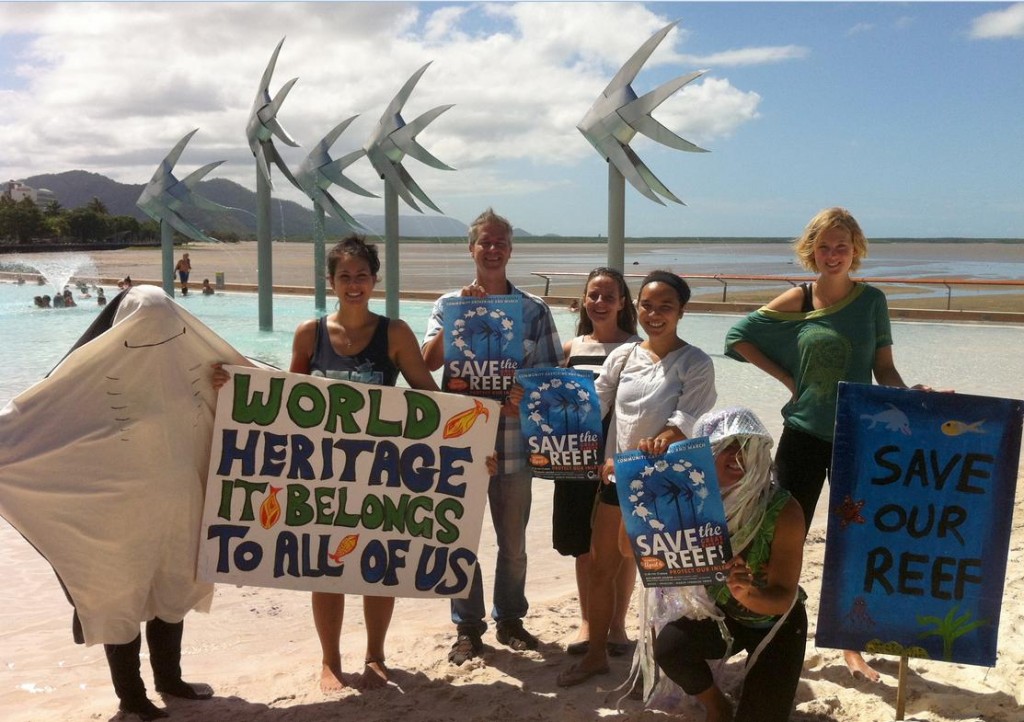 Protest to stop Queensland Resources Council dumping dredge spoil inside the Reef
Protest by Cairns and Far North Environment Centre (CAFNEC), June 2014
^http://cafnec.org.au/wp-content/uploads/2014/03/rally-promo-photo.jpg Protest to stop Queensland Resources Council dumping dredge spoil inside the Reef
Protest by Cairns and Far North Environment Centre (CAFNEC), June 2014
^http://cafnec.org.au/wp-content/uploads/2014/03/rally-promo-photo.jpg
.
Further Reading:
.
[1] IUCN World Parks Congress (Sydney 2014), International Union for Conservation of Nature, ^http://worldparkscongress.org/
.
[2] ‘Global Eco-Tourism in Protected Areas‘, by EcoTourism Australia, >2014 Global Eco Tourism in Protected Areas.pdf (1.1MB, 2 pages)
.
[3] Great Barrier Reef Marine Park Authority (website), Australian Government, ^http://www.gbrmpa.gov.au/
.
[4] Fight for The Reef (website), Australian Marine Conservation Society, ^https://fightforthereef.org.au/risks/dredging/
.
[5] No Hunting in National Parks (website), The National Parks Association of NSW, ^http://nohunting.wildwalks.com/
.
[6] ‘An international perspective on tourism in national parks and protected areas‘, by J.G. Castley (2014), >An international perspective on tourism in national parks and protected areas.pdf (100kb, 10 pages)
.
[7] ‘EXTRA: ‘Nasho’, Royal National Park, Sydney’s neglected southern jewel‘, by Nick Galvin, Journalist, Sydney Morning Herald, 20140613, ^http://www.smh.com.au/nsw/extra-nasho-royal-national-park-sydneys-neglected-southern-jewel-20140613-zs6d8.html
.
[8] ‘Paradise lost: Australia’s heritage jewels under threat‘, (audio), ABC ‘Background Briefing’ radio programme, by Sarah Dingle, 20131208, ^http://www.abc.net.au/radionational/programs/backgroundbriefing/2013-12-08/5132224
.
 White Lemuroid Possum
(Wet Tropics of Queensland World Heritage Area in Danger)
Has the white lemuroid possum become the first mammal to go extinct due to global warming? White Lemuroid Possum
(Wet Tropics of Queensland World Heritage Area in Danger)
Has the white lemuroid possum become the first mammal to go extinct due to global warming?
The species, normally found above 1000m, has not been sighted during any nighttime spotlighting expedition since 2005. Experts fear a temperature rise of 0.8 degrees Celsius may be to blame for the animal’s disappearance.
[Source: ^http://www.wherelightmeetsdark.com/index.php?module=newswatch&NW_user_op=view&NW_id=453]
.
Tags: Dugong, Dugong strandings, Gladstone Harbour, Great Barrier Reef, Great Barrier Reef Marine Park, Green Turtle strandings, greenwashing, Humpback Whale, International Union for Conservation of Nature, iucn, national parks, National Parks and Wildlife Service, Parks Australia, Protected Areas in Australia, Queensland Government, The Great Barrier Reef Marine Park Authority, UNESCO world heritage in danger list, Wet Tropics of Queensland World Heritage Area in Danger, White Lemuroid Possum, World Heritage, World Parks Congress
Posted in Critically Endangered Wildlife (CR), Threats from Government Funding Neglect, Threats from Greenwashing, Threats from Pollution, Threats from Tourism and Recreation, Threats from Weak Environmental Laws | No Comments »
Add this post to Del.icio.us - Digg
Saturday, November 16th, 2013
 Abject failure by emergency MANAGEMENT
Buena Vista Road, Winmalee, Blue Mountains, 18th October 2013 Abject failure by emergency MANAGEMENT
Buena Vista Road, Winmalee, Blue Mountains, 18th October 2013
In anyone’s assessment, except for those in charge, 193 homes lost with 109 damaged is not a firefighting success for the unlucky Blue Mountains communities of Springwood/Winmalee, Yellow Rock and Mount Victoria.
.
How often do bushfire fighters have to watch on in frustration from their fire trucks on a road towards a bushfire, knowing they are helpless with the tools they have to extinguish it?
In the case of a single house fire in an urban setting, the fire truck is the tried and tested appropriate appliance to respond. Fire fighters can readily drive up to and park right out the front and hose down a house fire. But applying this classic firefighting method to wildfires in expansive and rugged bushland with steep and often inaccessible terrain is all but useless, like square peg in round hole thinking.
Yet whenever government announces pre-election funding to bushfire fighting it is kneejerk unimaginatively more fire trucks, costing millions and fixing nothing.
It comes down to political value judgment.
.
 Water, water, in fire trucks everywhere, nor any drop to douse the fires
with apologies to English poet Samuel Taylor Coleridge in his 1798 poem, ‘The Rime of the Ancyent Marinere’.
Water, water, in fire trucks everywhere, nor any drop to douse the fires
with apologies to English poet Samuel Taylor Coleridge in his 1798 poem, ‘The Rime of the Ancyent Marinere’.
.
Many wildfires spark from lightning strikes in remote terrain and spread into hilly bushland with few access roads. More so these days, the disturbing arson fetish has become more deadly.
The consequential wildfires in inaccessible bushland country logistically render the fire truck ineffectual as the prime bushfire fighting response. Fire trucks despatched down along fire trails that are surrounded by bushland on RFS maps provide a false sense of access and ability, but they are death traps for firefighters in fire trucks during a wildfire in extreme conditions.
Just last September during the Londonderry grassfire in outer western Sydney, a fire truck along an outer urban road was overcome by flames and destroyed. It wasn’t even a fire trail.
.
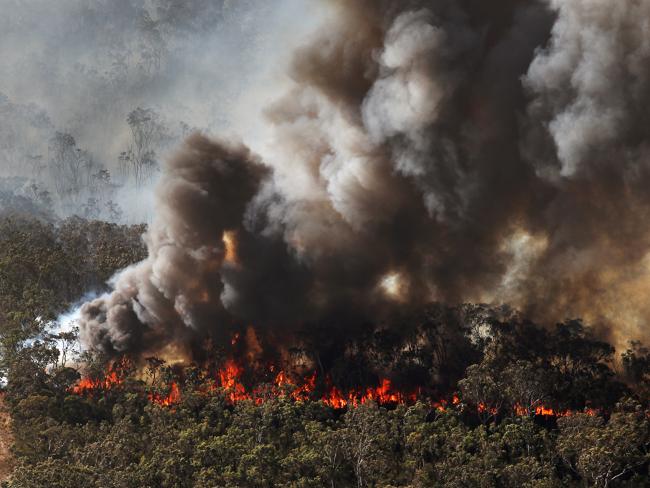 Wildfire beyond the reach of fire trucks through Windsor Downs Nature Reserve, western Sydney, September 2013
[Source: ^http://www.dailytelegraph.com.au/news/one-hell-of-a-start-to-an-early-summer-as-firestorms-sweep-across-nsw/story-fni0cx4q-1226716072987 ] Wildfire beyond the reach of fire trucks through Windsor Downs Nature Reserve, western Sydney, September 2013
[Source: ^http://www.dailytelegraph.com.au/news/one-hell-of-a-start-to-an-early-summer-as-firestorms-sweep-across-nsw/story-fni0cx4q-1226716072987 ]
.
This is where fast targeted airborne response within the first hour of ignition is more effective. The application of large quantities water bombing of a fire front is surely the preferred lead bushfire fighting response strategy. This is not to say that ground support is not needed, but the evidence is that traditional truck based ground support as the lead response strategy is simply not cutting the mustard.
But such strategy requires considerable investment and planning and requires expertise. It demands a military standard realignment of the emergency response co-ordination end-to-end from early warning systems monitoring, to ignition detection, to fast airborne response with all the latest communications technology available. Clearly this is well beyond the volunteer business-as-usual bush firefighting model that governments have lackadaisically drip fed since colonial times.
On Thursday 17th October 2013, at around 2pm, a bushfire started upwind in Springwood in the Blue Mountains in New South Wales. The fire was purportedly ignited by arcing of touching residential overhead powerlines in strong wind conditions. The Sydney Morning Herald ran a story a few days later on Sunday 20th October, that preliminary investigations had found that a tree with cables running through its branches is believed to be the seat of the fire that jumped a road then engulfed houses in Springwood, spotting over to Winmalee and Yellow Rock.
Coincidentally, a few days prior to the wildfire tragedies of Thursday 17th that separately impacted Winmalee, Yellow Rock and Mount Victoria, on 15th October New South Wales Premier Barry O’Farrell had publicly announced the arrival of an additional large firefighting Air-Crane helicopter to be leased from of all places, impoverished Greece.
Nicknamed the ‘Gypsy Lady‘, this lifesaving Erickson S-64 Air-Crane has deserved fame for its massive water bombing ability beyond any Dad’s Army Isuzu truck.
O’Farrell apparently immediately deployed it to fight bush fires according to government propaganda and photos are offered of it in action at Winmalee. But did it? So where was it and a second leased Air-Crane, ‘Elvis’, deployed on the critical multiple wildfire afternoon of Thursday 17th October?
Such government performance facts are kept secret from the public. The government’s promotional photo below of an Air-Crane water bombing bushland over Winmalee was dated Wednesday 23rd October, extinguishing left over spot fires a week later. So where is the smoke? Where there is no smoke there is probably no fire. Was this photo for the media’s benefit? The caption for this photograph reads verbatim as follows:
“A firefighter looks on as Air-Crane Elvis drops water at the Linksview Road fire near Faulconbridge, in the Blue Mountains (sic) 23/10/2103 (AAP: Lukas Coch).”
.
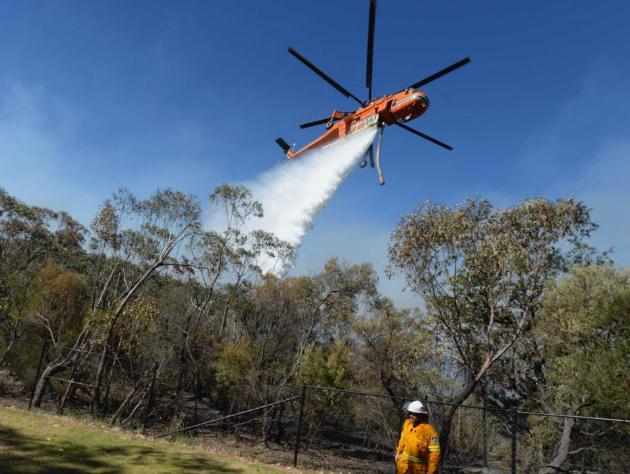 Game Changer
We can save you, if we are called in early enough.
The ‘Elvis’ Air-Crane over Winmalee, except the NSW Government’s promotional photo is dated 23rd October 2103?
[Source: ‘NSW bushfires: Crews battle to contain destructive blazes in Lithgow and Springwood’, 20131020, ABC, ^http://www.abc.net.au/news/2013-10-19/fire-crews-battle-blazes-in-lithgow-and-springwood/5033558]
Game Changer
We can save you, if we are called in early enough.
The ‘Elvis’ Air-Crane over Winmalee, except the NSW Government’s promotional photo is dated 23rd October 2103?
[Source: ‘NSW bushfires: Crews battle to contain destructive blazes in Lithgow and Springwood’, 20131020, ABC, ^http://www.abc.net.au/news/2013-10-19/fire-crews-battle-blazes-in-lithgow-and-springwood/5033558]
.
It was reported two days after Blue Mountains residents tragically lost over 200 family homes to the bushfires, that a crucial water bombing Erickson S-64 Air-Crane had been grounded at Bankstown Airport during the two day bushfire crisis, because authorities claimed they needed an American engineering and flight crew to operate it.
But then still without such American crews on Saturday 19th October, the Air-Crane was authorised to fly to Springwood, despite the absence of the US crew.
While it will now be used to assist in combatting ongoing fire hazards, the water dumper was forced to sit idle while bushfires ravaged the state on Thursday, Friday and most of yesterday. The craft is believed to be the same chopper, nicknamed ‘Ichabod‘, which was flown over on a cargo plane with the previously mentioned helicopter, ‘Gypsy Lady‘ since has been put to use – from Greece to Sydney Airport.
Previously, a qualified American team arrives with the helicopter, enabling it to operate, however the team for the Ichabod were only due to fly to Australia at a later date. As bushfires started earlier than expected, authorities were caught off-guard and forced to scramble without the use of the second craft.
The Erickson S-64 Air-Crane helicopters are able to waterbomb a fire with 10,000 litres of water and are frequently brought to Australia from the United States for the bushfire season and hot weather. But due to the Erickson Air-Crane’s absence from the fire front, ordinary choppers used by the RFS were mobilised. However it’s understand those replacement craft can only dump 300 litres of water, just 3% of that of the Erickson Air-Crane.
[Source: ‘Critical US water bomber grounded during NSW bushfire crisis’, by Yoni Bashan, State Political Reporter, The Sunday Telegraph, 20131019, ^http://www.dailytelegraph.com.au/news/nsw/critical-us-water-bomber-grounded-during-nsw-bushfire-crisis/story-fni0cx12-1226743108424]
.
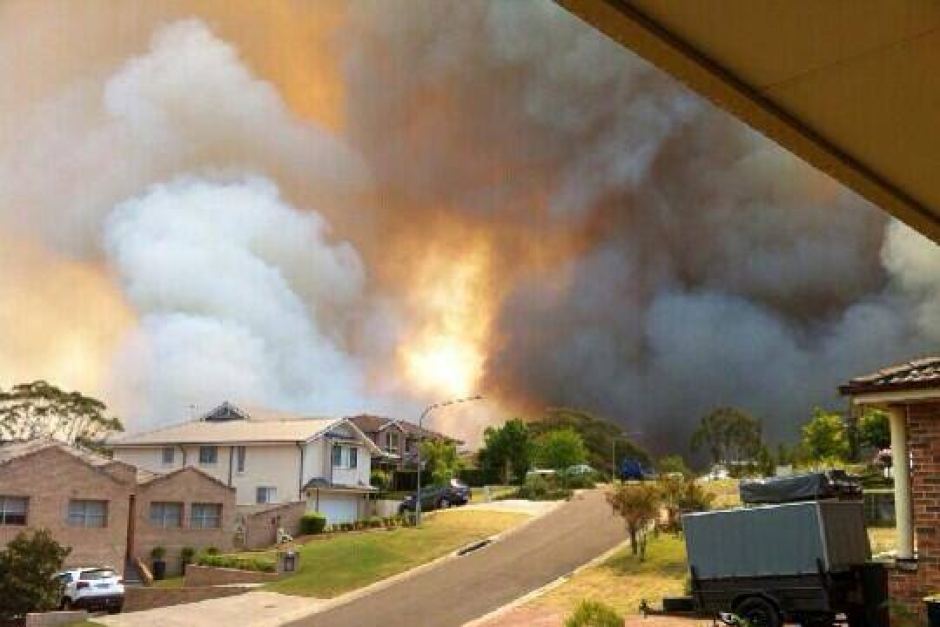 Springwood, 17th October 2013
Evacuate to where? We’re at work in the city so how can we save our valuables in time?
We have no alternate accommodation as the bloody government presumes.
We can’t afford insurance. Springwood, 17th October 2013
Evacuate to where? We’re at work in the city so how can we save our valuables in time?
We have no alternate accommodation as the bloody government presumes.
We can’t afford insurance.
.
So on the 17th October the Blue Mountains bushfires escaped ground control, leading to at least 193 homes lost and at least another 109 damaged and 3,500 hectares of bushland burnt with uncounted wildlife incinerated. The wildlife cost is always ignored.
No facts are forthcoming from the New South Wales Government about the performance of the firefighting. Why not?
- What was the estimated time of ignitions respectively at Winmalee and Yellow Rock?
- How was each wildfire reported and detected by the authorities?
- What was the elapsed time from the estimated ignition times and the respective times the RFS became alerted?
- What was the elapsed time from the estimated ignition times and the RFS response being despatched (leaving the depots)?
- What was the elapsed time from the estimated ignition times and the RFS response arriving on site to suppress the respective wildfires?
- What time was the first house impacted by wildfire?
- What time did airborne water bombing on the wildfires commence?
- What time did aircrane water bombing on the wildfires commence?
.
Such facts are not in the government’s interest to publish because it well knows that its gross under-resourcing of bushfire emergency management exposes it to negligence and cost demands.
It comes down to political value judgment.
.
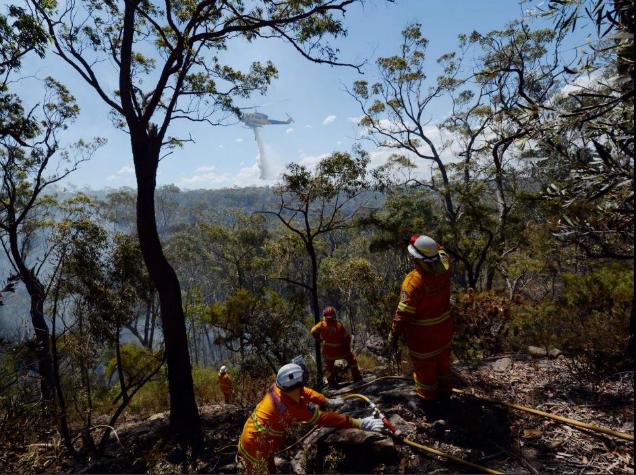 3% water capacity airborne response simply too little too late 3% water capacity airborne response simply too little too late
.
Year on year wildfire and deliberately lit hazard reductions escape control and cause the incineration of vast swathes of the remaining natural landscape. Some years people and their homes are lucky, moreso a factor of mild weather than emergency management performance. In 2009 it was Victoria’s unlucky turn.
Across Australia, bushfire detection, response and suppression is repeatedly shown to be so woeful as to be incompetent.
Government avoidance of seriously effective investment into emergency management, sees it instead resort to credibility damage control propaganda and to playing politics. It hides behind the goodwill of the volunteers, since anyone who dares criticise the performance of noble volunteers can only be publicly vilified. The government resorts to defeatist attribution of the bushfire emergency to uncontrollable Acts of God – catastrophic weather conditions in which nothing we can do would make any difference. It runs public announcements of impending Armageddon, Declares a State of Emergency as if it were 1939 Black Friday every summer and its emergency services head are instructed to do supportive drama queen performances.
Now around where the fires started there is little bushland left and little reason to stay. House values are down and people are selling up and moving off Mountains.
Government’s think their shit never stinks. Paid ambulance emergency response have a service charter to arrive on site after a 000 call within 20 minutes. But bushfire fighting has no such accountable charter. Rather the government’s emergency response duty is delegated to local volunteers charged to do their best with what they’ve got.
Typically, Rural Fire Service bushfire fighters, except for a few government paid white shirts in Homebush, are invariably unpaid volunteer members of the local community. When an emergency 000 call from a member of the public is despatched to the local brigades, the volunteers pre-occupied with their paid day jobs and have to drop everything. They are not paid to be on standby at fire brigade depots like the NSW Fire Brigades, irrespective of heightened times of high bushfire risk. The volunteers are not paid by government at all, and have to rely upon local charities for food and even for bottled water.
The last resort of the under-resourced bushfire brigades is to fight fire with fire.
.
 Scorched Earthing has become the last sad firefighting bastion of second class firefighters denied effective resources. Forced to fight slaughter with slaughter, or cruelty with hate. Scorched Earthing has become the last sad firefighting bastion of second class firefighters denied effective resources. Forced to fight slaughter with slaughter, or cruelty with hate.
.
The Greater Blue Mountains continues to be torched and scarred by its own custodian the National Parks and Wildlife Service. Its habitat and wildlife are being incinerated without measure or care.
Just like the mining and farming pollution impacts upon the integrity of the once Great Barrier Reef, the Greater Blue Mountains natural values are been irreversibly altered. Both the Great Barrier Reef and the Greater Blue Mountains need a cry for help and be added to UNESCO’s endangered list.
But putting Australia on an international ‘list of shame’ is but a small price. It comes down to political value judgment.
.
[The author is a licensed commercial helicopter pilot]
.
Tuesday, April 23rd, 2013
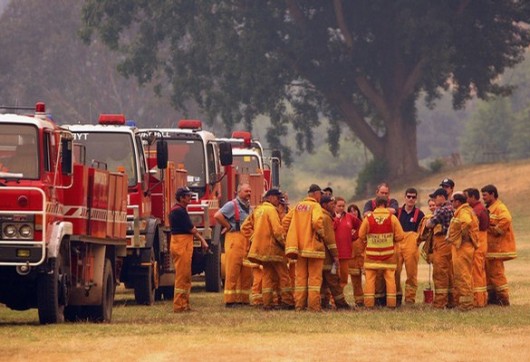 Emergency Services men and women, some paid, most unpaid;
put themselves in harm’s way in dedicated service to our country Emergency Services men and women, some paid, most unpaid;
put themselves in harm’s way in dedicated service to our country
.
.
Emergency Services serve our Country
.
<<The role of a firefighter in today’s society – be it urban, rural, natural environment, volunteer, career, industrial, defence force, aviation, motor sport, or other is one of dedication, commitment and sacrifice – no matter what country we reside and work in. In the fire service we fight together against one common enemy – fire – no matter what country we come from, what uniform we wear or what language we speak.>>
~ Lt JJ Edmondson, 1999
.
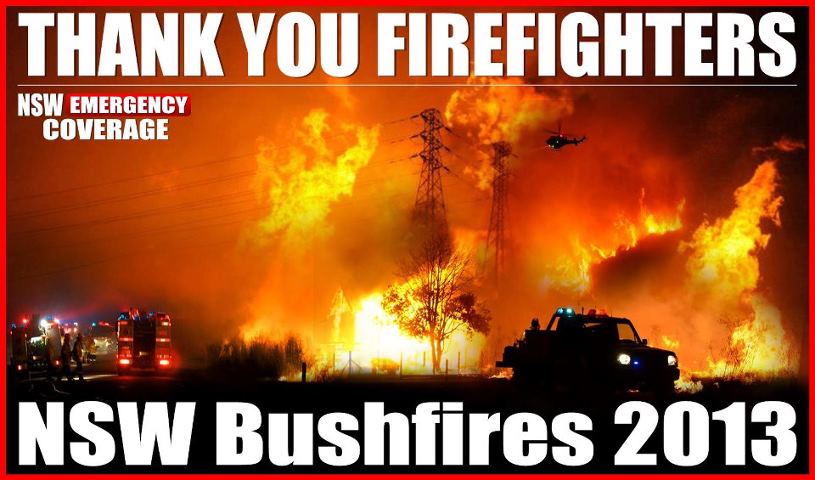
.
<<Firefighters dedicate their lives to the protection of life and property. Sometimes that dedication is in the form of countless hours volunteered over many years, in others it is many selfless years working in the industry. In all cases it risks the ultimate sacrifice of a firefighter’s life.
International Firefighters’ Day (IFFD) is a time where the world’s community can recognise and honour the sacrifices that firefighters make to ensure that their communities and environment are as safe as possible. It is also a day in which current and past firefighters can be thanked for their contributions.
International Firefighters’ Day is observed each year on 4th May. On this date you are invited to remember the past firefighters who have died while serving our community or dedicated their lives to protecting the safety of us all. At the same time, we can show our support and appreciation to the firefighters world wide who continue to protect us so well throughout the year.>>

^http://www.firefightersday.org/
.
Across Australia, the vital life-saving job of Civil Emergency Services (an umbrella term) extends beyond the professionally paid urban fire brigades.
Over decades, the task of emergency service has evolved on a state basis to include multiple independent agencies including the various rural firefighting services, ambulance services, State Emergency Services, emergency rescue services, police and their associated rescue services, helicopter rescue services such as Careflight, St John Ambulance Service and the Australian Volunteer Coast Guard, Surf Life Saving, amongst others.
Most of these agencies rely in the most part upon volunteers from the community prepared to sacrifice their time and lives for their country to help and save others in distress.
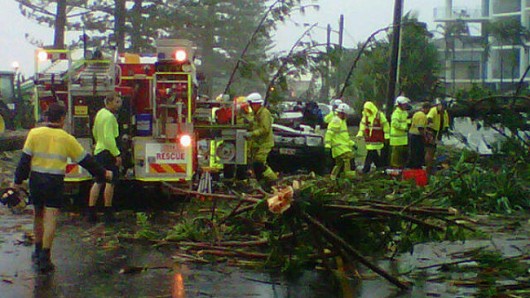 Emergency Services respond to a tornado hitting Bargara, coastal Queensland
Australia Day 2013 Emergency Services respond to a tornado hitting Bargara, coastal Queensland
Australia Day 2013
.
Emergency Services forced to rely on public charity
.
<<While Australia is one of the most bush-fire prone countries in the world, its fire-fighting services are organised on a state-by-state basis and rely heavily on thousands of unpaid volunteers. Over the past year, the seriously under-funded and under-equipped services, both professional and voluntary, have been subjected to systematic cutbacks.
The cuts, which have eroded fire and emergency services capacities, are part of ongoing reductions to vital social services—health, education and welfare—by federal Labor government and state Liberal governments.
Currently there are just over 13,000 full-time fire fighters in Australia, with more than 219,000 unpaid volunteers, drawn from local communities. The NSW Rural Fire Service (RFS), the largest agency, has a volunteer base of over 70,000 and operates more than 7,000 vehicles.
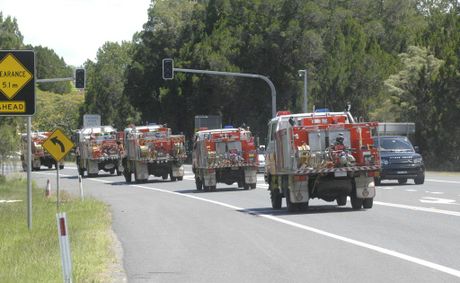
NSW Emergency Services Minister Michael Gallagher acknowledged last year that the current summer bushfire season had “the potential to be one of the worst in years.” Yet, the state Liberal government, following on from the previous Labor government reductions, announced in last year’s budget that it was slashing staff funding to the RFS by $11.7 million over four years. The move is expected to axe at least 120 jobs, or 1 in 8 full-time positions.
The state government also wound back the Rural Fire Fighting Fund, which helps pay for a range of RFS operations, by $8 million—from $271 million to $263 million for 2012-2013. In addition, it is cutting NSW Fire and Emergency, which employs most of the state’s full-time fire-fighters, by $70 million over the next four years.
According to a recent review by the NSW auditor-general, total funding for the RFS has been reduced by almost 7% and the number of fire-fighting tankers supplied or refurbished has decreased from 216 to 177 during the past two years.
Similar cuts have been imposed by the Victorian state government on the Country Fire Authority (CFA). The CFA currently has a 44,000-strong volunteer base, down from 83,000 in 1998.
Last year, the Victorian Liberal government announced it would axe $66 million from its fire services budget—$41 million from the CFA and $25 million from the Metropolitan Fire Brigade. Fifty paid CFA positions were also eliminated during the year, as a result of earlier budget decisions.
A recent CFA newsletter said the organisation would have to “reduce and defer building maintenance, reduce funds available for volunteer uniform expenditure,” manage volunteer recruitment and “encourage those brigades capable of doing so to fully fund their own initiatives.”
These cutbacks have been imposed despite Victoria’s catastrophic 2009 Black Saturday bushfires, which killed 173 people, including 23 children, and incinerated 450,000 hectares and 2,100 homes. Political responsibility for this heavy loss of life lies with the previous state Labor government of Premier John Brumby. Its so-called “stay or go” policy and other cost-cutting measures encouraged individuals to devise their own fire response plans and attempt to defend their homes when faced with approaching infernos.

A royal commission made limited criticisms and issued 67 recommendations to improve fire safety. More than two years after it handed down its final report, only 35 of the recommendations have been implemented. Less than 360 out of 850 fire trucks have received recommended fire safety upgrades and only one fire refuge is operational.
The Victorian government’s claims to have improved emergency communications were exposed on the first day of this month’s heatwave when the emergency web site crashed. The web site received 700 hits a second, double the level planned for by the CFA and state government.
Similar cuts are being imposed in other states. Up to 20 administrative positions are being slashed from the Queensland Rural Fire Service, and 18 full-time jobs from the Tasmanian Fire Services. In Western Australia, the Fire and Emergency Service Authority is not filling vacant positions and has been directed by the state government to reduce operating costs by almost $400,000 during the current financial year.
None of these measures, or the previous years of gross under-funding by Liberal and Labor state governments alike, would have been possible without the political assistance provided by the two principal unions—the United Firefighters Union and the Fire Brigade Employees Union—that cover most professional fire-fighters.
Opposed to any national mobilisation of fire fighters, the unions have worked to dissipate their members’ concerns with harmless protests, while appealing to the various state administrations to negotiate cost-cutting and productivity deals. Fire union protests last year in Sydney and Melbourne attempted to promote illusions in the return of state Labor governments—that is, the same party that was responsible for the previous rounds of cutbacks.>>
[Source: ‘Australian fire-fighting budget cuts place lives at risk’, 20130119, by Mark Church, ^http://www.wsws.org/en/articles/2013/01/19/bush-j19.html]
.
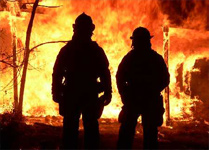
While governments always manage to find millions and billions for “other priorities”, our Emergency Services are forced to rely on the goodwill and charity of local communities to maintain basic operational expenses.
That the men and women who volunteer their time and put their lives on the line to respond when disaster strikes, also have to fundraise their service is a damning indictment of our governments’ abrogated duty of care to protect life and property. Annual doorknock appeals and sausage sizzles are not the way to fund Emergency Services. What are our taxes paid for?
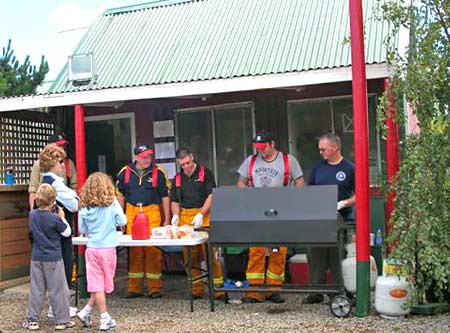 CFA Sausage Sizzle CFA Sausage Sizzle
.
Psychological Trauma eating away at Emergency Services
.
<<A hidden toll of psychological trauma among Victorian firefighters may be leading to suicide, alcohol abuse and depression.
A report by the University of Newcastle’s Centre of Full Employment and Equity also reveals firefighters’ biggest stress is their role as a first responder to medical emergencies and that some believe they are not getting adequate support. The report, written by research professor William Mitchell and research fellow Beth Cook and commissioned by the firefighters’ union, was released to the public on Monday 18th February 2013.
It comes days before the Auditor-General releases a report expected to show high rates of unplanned leave by professional firefighters (see below).
The University of Newcastle’s report warns that:
”given the psychological impact of firefighting – higher prevalence of PTSD [post-traumatic stress disorder], depression, anxiety and alcohol or drug use – there is a probability that firefighters may be more likely to commit suicide”.
Firefighters union secretary Peter Marshall said the report – including figures from one study showing 68% of firefighters recorded moderate symptoms of PTSD – revealed firefighters were sitting on a ”ticking psychological time bomb”.
He said existing support programs, which include a peer-to-peer service, were inadequate and budget cuts to the metropolitan and country fires services had exacerbated the problem.
.
”The government is drawing on the physical and mental reserves of firefighters like never before but not giving them the support.”
.
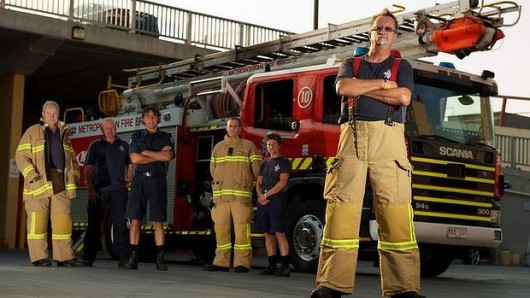 MFB Firefighter Danny Ward supported by his colleagues
(Photo by Wayne Taylor) MFB Firefighter Danny Ward supported by his colleagues
(Photo by Wayne Taylor)
.
But a spokesman for Deputy Premier and Emergency Services Minister Peter Ryan said ”this year’s fire services budget was the second-biggest on record, surpassed only by last year’s budget”, which paid for many of the bushfire royal commission recommendations. The spokesman said the government would wait to read the union-commissioned study before it responded.
The Metropolitan Fire Brigade’s chief officer, Shane Wright, stressed that existing support programs were comprehensive and effective. Mr Wright also said that, compared with other emergency services, firefighters had smaller incidences of stress-related WorkCover leave.
Metropolitan firefighters interviewed for the report singled out stress factors including ”the introduction [in 2000] of Emergency Medical Response [in which firefighters are first respondents to medical emergencies] and the ageing of the workforce in the MFB”, while professional CFA firefighters ”singled out the deterioration in the numbers and reliability of volunteers as the single most notable change for the organisation”.
Asked to rank their most stressful incidents, metropolitan firefighters listed fire fatalities and dealing with seriously injured children or the sudden death of an infant.
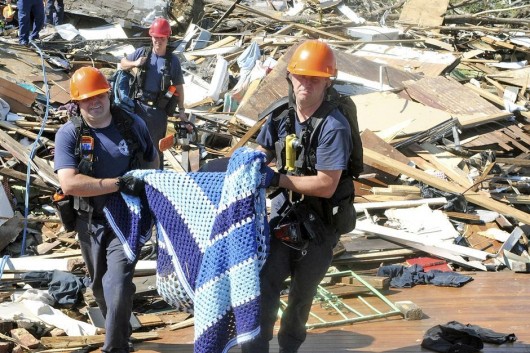 Burmingham Fire and Rescue
(this was a dog, but it gets a whole lot worse) Burmingham Fire and Rescue
(this was a dog, but it gets a whole lot worse)
.
The report states:
”Participants were concerned that the intensity and level of exposure increased over time and left all firefighters vulnerable to PTSD as their career progressed, and even after retirement, when they lost the support of co-workers. Some participants expressed a belief that many firefighters suffered from undiagnosed PTSD or depression.”
.
The focus groups also reported perceived insufficient support from management to deal with stress. However, the study also noted firefighters were often reluctant to seek help, sometimes preferring to self-medicate with alcohol, and that the existing data around stress levels was incomplete.
A 30-year firefighting veteran, Danny Ward, told Fairfax Media that while he and his colleagues were well trained to deal with fires, they are not sufficiently supported to deal with the mental impact of attending car accidents, cot deaths, heart attacks and drug overdoses.
.
”You don’t tell the kids and wives about the day that you’ve had. You just go upstairs and lie in bed,” Mr Ward said. ”The PTSD problem is just waiting to explode.”
.
[Source: ‘Report reveals personal toll on firefighters’, 20130218, by Nick McKenzie and Richard Baker, ^http://www.theage.com.au/victoria/report-reveals-personal-toll-on-firefighters-20130217-2elcb.html]
.
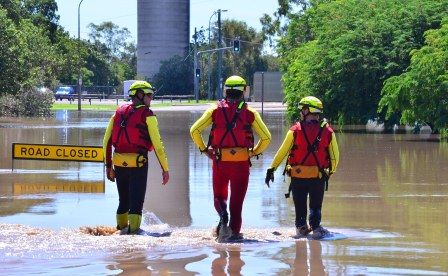
.
Trauma Report Extract:
.
<<Firefighters have one of the most dangerous jobs in the world and suffer high levels of physical and psychological injury, according to a study by a research unit of the University of Newcastle. Researchers examined international and Australian health studies and interviewed local firefighters. They found that the changing role of firefighting is having a big impact on the health of career firefighters and volunteers.
Fires are not the only issue. Firefighters are also concerned at the stress of dealing with emergency medical response (EMR), suicides, drug incidents, traumatic events involving children such as SIDS, increased violence, and the threat of terrorism. Firefighters are found to have increased levels of Post Traumatic Stress Disorder (PTSD) and other illnesses.
Firefighting differs from other emergency services they get the heavy jobs, the ‘dirty’ and dangerous jobs, and are often first on scene. These risks cannot be mitigated. It is the nature of the job. Firefighters go into danger, as others flee.
“Firefighters are exposed to greater stresses than other workers even if management undertake the most extensive risk management.” (Report page 33)
The pressure of budget cuts to fire service s is also impacting on the stress levels of firefighters.
Organisational stressors include inadequate staff, and a lack of communication and consultation.
Firefighters one of the fittest sectors of the workforce when they begin their career suffer above average rates of cancers, heart attacks, chemical and asbestos exposure, PTSD, and other risks.
They often keep their concerns to themselves, and some take to self medication through alcohol and other drugs. The increased fitness of the workforce when they begin their firefighting career also helps mask health issues (the healthy worker effect).
Support services have not kept pace with the changing role of firefighters. Management may view its support programs as successful, but often the reality is otherwise. Management is disconnected from the workers on the fire ground. In the CFA, peer support personnel are predominantly volunteers with less incident experience than fulltime firefighters.
The hidden cost of these physical and psychological injuries falls on the firefighters, family, fire services and communities, as firefighters are self medicating, taking unplanned time off to recover and going untreated as they do not have access to adequate support to address the root causes.
Increasingly firefighters are using such coping mechanisms to mask the true effect of the acute and accumulated exposure that they are confronted with in the workplace. There is a high cost to the individuals concerned, their families, and the fire services which employ them.>>
.
[Source: ‘Occupational health effects for firefighters: The extent and implications of physical and psychological injuries‘ (Synopsis), a report by The Centre of Full Employment and Equity (CofFEE) (a research unit of the University of Newcastle), February 2013, commissioned by the United Firefighters Union of Australia, Victorian Branch,^http://www.firecrisis.com.au/wp-content/uploads/2013/02/CofFEE-report-synopsis.pdf]
.
.
.
.
Let Emergency Services march with Diggers on ANZAC Day
.
An ex-Vietnam vet and currently a politician in New South Wales, Charlie Lynn, has broken ranks to urge his ‘‘mates’’ in the leadership of the Returned and Services League (RSL) to recognise the dedicated, courageous and honourable service of emergency services personnel by welcoming them to march on Anzac Day.
.
“They stand bravely in the path of fire, risking their lives for mate and country – just like a soldier.”
.
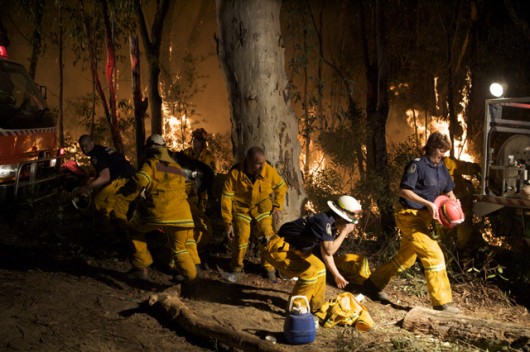 Volunteer Fire Fighters Association Volunteer Fire Fighters Association
.
Now a member of the state government and a war veteran, Charlie Lynn, says Rural Fire Service (RFS) and State Emergency Service (SES) volunteers should be given the honour of marching on Anzac Day.
Mr Lynn, a Liberal Party MP who served in Vietnam, has broken ranks to urge his ”mates” in the leadership of the RSL to consider broadening the scope of Australia’s sacred military day.
”I’ve been thinking about what Anzac represents, and to me it’s about selfless service to the nation and sacrifice,” Mr Lynne said.
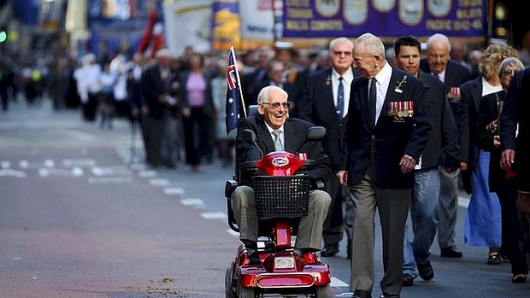 People in the ANZAC Day march as it marches down George St, Sydney. People in the ANZAC Day march as it marches down George St, Sydney.
(Photo by Tamara Dean)
.
‘RFS and SES volunteers give up days and weeks of their time to train and be prepared then they risk their lives at times of extreme danger like we’ve seen over the past week. To me that’s the same sort of sacrifice that soldiers make.”
Mr Lynn said the inclusion of volunteers from outside military ranks would breathe new life into Anzac Day marches in country towns where numbers of war veterans have waned.
”Anzac Day numbers are declining rapidly. We’re not seeing the bulk numbers marching like we did after Word War I and World War II, and something will need to be done to keep it alive,” he said. ”Virtually every town in Australia has an RFS, an SES and a war memorial. That’s what makes us unique. This would be a way to bring all those together and keep the spirit of Anzac Day alive and keep people actively participating in it rather than being spectators.”
But Mr Lynn, who has guided more than 60 groups along the Kokoda Track, knows he has a fight on his hands to convince Don Rowe, the NSW president of the RSL.
Mr Rowe said he would have a ”big problem” with allowing non-services personnel and their descendants into the main Sydney march but would consider greater involvement of volunteers in rural areas.
”We’ve got a set of guidelines and there is no talk of changing them. Anzac Day and the march is for people who have served in our defence forces. It’s about them.”
Mr Rowe said 20,000 people marched and the number was rising due to more descendants marching.
RFS volunteers already helped co-ordinate marches in towns, Mr Rowe said. ”In rural areas it’s up to the sub-branches as to what level of involvement those volunteers have and that’s no problem for us but when it comes to the main march in Sydney we would have a big problem with that.”
The nation’s most famous RFS volunteer, Tony Abbott, declined to comment on the idea as he began his family holiday on Saturday.
The Premier, Barry O’Farrell, said he was cool on the idea but flagged a separate ceremony to honour the fire volunteers who have been battling bushfires across the state over the past week.
”It’s an interesting idea but my personal view is that Anzac Day should remain a day to honour those who’ve served our country in war,” he said. ”There will be appropriate acknowledgement of the efforts of emergency workers during the current fire crisis once the crisis is over.”
A spokesman for the RFS said: ”At this stage we don’t have a position on that.”
[Source: ‘Let firies march with Diggers like me on Anzac Day, says MP’, 20130113, by Heath Aston, Political Reporter, Sydney Morning Herald, ^http://www.smh.com.au/nsw/let-firies-march-with-diggers-like-me-on-anzac-day-says-mp-20130112-2cmi0.html]
.
That they do not pick up a rifle makes them no less honourable for recognition for their dedicated service to Australians and to our country.
.
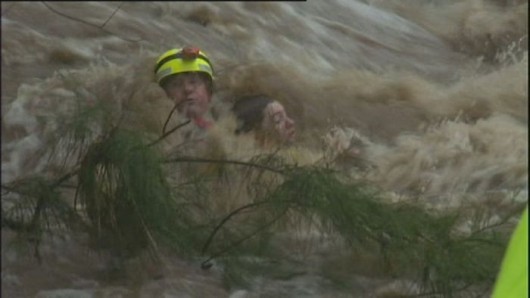 Swift Water Rescue by Emergency Services last January
Source: ‘As it happened: Tornadoes hit coastal towns’, 20130127 Swift Water Rescue by Emergency Services last January
Source: ‘As it happened: Tornadoes hit coastal towns’, 20130127
http://www.abc.net.au/news/2013-01-26/flood-havoc-as-rain-lashes-qld/4485304
.
Our taxes should also be paying these dedicated selfless souls and paying full premiums for all their personal insurances so that should tragedy occur in the line of duty, dependents will be properly cared for and shall never want for the basics of life.
It is a disgrace that governments go into hiding to avoid financial responsibilities of those who have served our country who putting themselves in harms way. Why should the public have to double dip and charities have to do the financial job of government in the financial aftermath of national emergencies?
Same same in 2009 Black Saturday, Cyclone Yasi, Brisbane Floods, Canberra Firestorm, Ash Wednesday, etc, etc, etc.
.
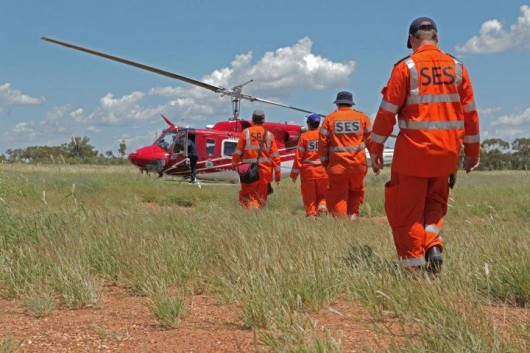 . .
Further Reading:
.
‘Management of Unplanned Leave in Emergency Services’
Tabled by the Victoria Auditor-General’s Office on 6th March 2013

.
<<Operational staff at Ambulance Victoria (AV), the Metropolitan Fire and Emergency Services Board (MFESB) and Victoria Police (VicPol) are more likely to suffer injuries and emotional stress, and have higher rates of unplanned leave, than other public sector staff.
AV, MFESB and VicPol have each recognised the importance of managing unplanned leave. However, there are significant differences in how effectively and efficiently they are each managing the issues.
Both AV and VicPol have been generally effective and efficient in managing unplanned leave, although AV recognises the need to reduce the personal unplanned leave levels of paramedics and other operational staff.
AV and VicPol have effective management oversight, supported by sound and practical data that enables their frontline managers to manage and support staff. They are aware of the causes of unplanned leave and have either implemented, or are developing actions to address these.
However, MFESB needs to improve considerably. Compared to its peer agencies it has the poorest unplanned leave performance. MFESB’s management has been aware of the causes of personal unplanned leave since 2000 but it has not adequately addressed them. There is a lack of frontline management accountability for unplanned leave, and a lack of regular data on firefighters’ unplanned leave available to managers.>>
.
March 2013: Audit Summary
.
Background
.
Victoria’s public sector provides its staff with a range of leave benefits. These benefits include annual leave, parental leave and study leave, which are typically planned in advance with the employer.
Public sector staff are also provided with personal leave benefits to manage incidents such as illness, or the need to care for an ill family member. Additionally, staff injured at work have access to worker’s compensation leave. These types of leave are typically unplanned and occur unexpectedly.
All organisations experience some degree of unplanned leave which, given its nature, can create management and budgeting challenges. Unplanned leave can create significant financial costs, disrupt service delivery and compromise the achievement of organisational objectives. Attendance at work can be affected by:
- health and fitness problems
- barriers such as caring responsibilities or personal emergencies
- motivation.
.
Excessive unplanned leave can be a symptom of larger problems within an organisation, including poor occupational health and safety management, an unfavourable organisational culture, or insufficient controls over access to entitlements such as sick and carer’s leave. Operational staff in emergency services agencies, such as Ambulance Victoria (AV), the Metropolitan Fire and Emergency Services Board (MFESB) and Victoria Police (VicPol) are more likely to suffer injuries and emotional stress compared to their non-operational counterparts due to their high-risk work environment.
.
Conclusions
.
Victoria’s emergency service agencies—AV, MFESB and VicPol—have each recognised the importance of managing unplanned leave. However, there are significant differences in how effectively and efficiently they are each managing the issues.
Both AV and VicPol have been generally effective and efficient in managing unplanned leave, although AV recognises the need to reduce the personal unplanned leave levels of paramedics and other operational staff. AV and VicPol have effective management oversight, supported by sound and practical data that enables their frontline managers to manage and support staff. They are aware of the causes of unplanned leave and have either implemented, or are developing actions to address these.
However, MFESB needs to improve considerably. Compared to its peer agencies it has the poorest unplanned leave performance, which has been caused by ineffective management over the past decade.
MFESB’s management has been aware of the causes of personal unplanned leave since 2000 but it has not adequately addressed them. There is a lack of frontline management accountability for unplanned leave, and a lack of regular data on firefighters’ unplanned leave for managers at the station level. This needs to be addressed as a matter of priority.
.
Findings
.
Unplanned leave performance
In 2011–12, the number of shifts lost due to unplanned leave for operational staff at AV, MFESB and VicPol was 10.6, 11.6 and 9.6 per full-time equivalent (FTE) respectively.
Long average shift durations at AV and MFESB—11.77 hours and 12 hours—result in average time lost to unplanned leave of 124.6 hours and 139.5 hours per FTE respectively. VicPol’s shorter average shift length of 7.6 hours results in time lost to unplanned leave of 72.9 hours per FTE.
The level of unplanned leave at AV reflects a slight decline compared to 2010–11. While MFESB achieved a slight reduction in 2011–12, its unplanned leave has increased steadily since 2000. Unplanned leave for VicPol has remained constant and substantially below AV and MFESB.
.
Senior agency management oversight
Effective management of unplanned leave relies on the commitment and oversight of senior management. Senior managers set expectations by establishing policies, practices and the responsibilities of staff and managers. Sustained management attention is required to effectively identify and address the underlying causes of unplanned leave.
Each agency’s senior management is briefed on the types and levels of unplanned leave and the contributing factors, however the nature and extent of oversight and effective action varies.
Both AV’s and MFESB’s senior management regularly consider unplanned leave. AV’s senior management receives regular information on unplanned leave and enforces responsibilities at all levels of operational management. However, MFESB’s senior management has only strengthened its oversight of unplanned leave since 2010, and this has delayed its response to the issues it faces.
VicPol conducts reviews of operational groups every six months. These reviews provide senior executives with the opportunity to examine police managers’ operational performance and request specific action, including managing unplanned leave. However, the frequency of these reviews may limit VicPol’s ability to respond to systemic unplanned leave issues in a timely way.
.
Industrial constraints on decision-making
MFESB and the United Firefighters’ Union (UFU) entered into an enterprise agreement for firefighters in 2010. The agreement is legally binding on MFESB and UFU. It contains provisions that constrain MFESB’s ability to effectively and efficiently implement initiatives to manage unplanned leave.
The provisions in the enterprise agreement effectively require that any change affecting MFESB’s relationship with its staff be agreed upon with UFU. This has the potential to contribute to difficulty and delay in introducing reasonable mechanisms to hold firefighters, and their managers, accountable for personal unplanned leave that is not justified by illness or injury.
.
Identifying the causes and impacts of unplanned leave
Identifying the causes of unplanned leave provides agency management with the information it needs to develop appropriate responses. All agencies have undertaken work to identify the causes and impacts of unplanned leave, although the extent to which this has informed management actions varies.
AV, MFESB and VicPol all regularly monitor service levels, overtime costs and unplanned leave to identify trends and patterns that may point to local causes of unplanned leave. In addition, MFESB has commissioned two reviews to gain a greater insight into the causes of personal unplanned leave.
However, only AV and VicPol have taken effective action to address the underlying causes of unplanned leave. While MFESB has had the necessary information over the past decade, it has not taken appropriate action until recently.
.
Frontline management practices
Effective frontline management is a key part of unplanned leave management. Frontline managers are in a position to positively influence motivation, reinforce staff understanding of their responsibilities, and deal directly with staff taking high levels of personal unplanned leave.
.
Frontline management of unplanned leave
Frontline management of unplanned leave is sound at both AV and VicPol, with clear responsibilities for managing personal unplanned leave, and generally consistent follow-up with staff after periods of unplanned leave.
AV faces challenges embedding good practices in rural branches where team managers are primarily allocated to paramedic duties but also have a significant number of staff to manage. The importance of enabling these managers to better manage their staff is highlighted by the rate of personal unplanned leave in AV’s rural areas, which exceeded that in metropolitan areas by 2.6 shifts per full-time operational staff member in 2011–12.
In contrast, MFESB’s commanders have primary responsibility for managing unplanned leave but do not have direct relationships with their firefighters. This limits their capacity to effectively work with firefighters to address personal unplanned leave issues. While senior station officers and station officers are in the best position to manage unplanned leave, they do not play an active role in doing so.
.
Accountability of frontline managers
To effectively perform the role of a frontline manager, accountability for managing unplanned leave should be clear and managers should have access to support, advice and appropriate professional development. Accountability was strongest at both AV and VicPol, and again was weakest in MFESB.
AV’s team managers have primary responsibility for managing the unplanned leave of operational staff. Line management practices include regular reviews of unplanned leave and the actions of managers to address individual cases. Managers’ performance plans and appraisals reinforce their responsibility for effectively managing unplanned leave.
VicPol places responsibility for unplanned leave with senior sergeants who manage police stations. As with AV, line management practices include regular monitoring of unplanned leave, with senior sergeants expected to closely monitor cases of high unplanned leave.
MFESB is strengthening the role of firefighter commanders for managing unplanned leave. However, MFESB has not established the means to hold commanders, senior station officers or station officers, who manage individual fire stations, accountable for the unplanned leave of their teams.
.
Services and guidance for frontline management
The causes of unplanned leave are complex and managing it can be equally complex. Access to robust guidance and assistance from human resource experts is essential in providing effective management responses.
Frontline managers at AV and VicPol are well supported with advice on human resource management matters and unplanned leave data. This enables managers to confidently deal with staff issues in compliance with organisational policies.
However, MFESB does not have sufficient internal human resources expertise to assist managers to confidently interpret the firefighters’ enterprise agreement and handle staff matters in MFESB’s industrial relations environment. Further, it does not provide its frontline managers with data on the unplanned leave of individual firefighters. This is a significant weakness in MFESB’s approach to managing unplanned leave.
.
Human resource policies and processes
Effective management of unplanned leave requires agencies having clear policies and procedures that are regularly communicated, monitored and applied. Processes and systems for managing shift work should have the ability to respond to changes in staff availability, including changes resulting from unplanned leave.
.
Staff responsibilities
Each agency has sound procedures for recording and approving unplanned leave. However, the extent to which these procedures are effectively implemented varies across the agencies. Ineffective implementation diminishes the purpose and value of having these controls in place, and does little to encourage staff to account for their absences, or to deter discretionary unplanned leave.
AV has generally sound procedures for reporting and recording unplanned leave. AV’s operational staff are required to contact one of two state duty managers so that unplanned leave can be recorded and replacement staff rostered. Unplanned leave is initially recorded as ‘uncertified’ and is only changed after staff submit evidence to support the absence.
MFESB has two inconsistent sources of information for firefighters on the requirements for reporting and recording unplanned leave. In addition, MFESB’s procedures for validating evidence to justify unplanned leave are unreliable. Documentary evidence supporting unplanned leave recorded as ‘certified’ was not held on MFESB’s personnel files in 23 per cent of instances involving firefighters with high levels of unplanned leave. MFESB does not apply controls to reinforce staff members’ responsibility for providing evidence in support of unplanned leave.
VicPol has a consistent approach to reporting and recording unplanned leave. VicPol policy only requires that managers sight evidence of unplanned leave, rather than retain copies of evidence. While this creates some risk of inconsistency in applying procedures, VicPol has adequate controls that compensate for this risk.
.
Operational resource management
AV’s systems and processes for operational resource planning and management provide the capacity for AV to reduce the factors causing unplanned leave. It has thorough processes for planning the resources it requires to deliver ambulance services. AV has centralised call-taking and dispatch, and has recently introduced a statewide rostering system that provides for the efficient deployment of ambulance resources. However, central controls over rostering, while improving the efficiency of operational staff management, have reduced the flexibility previously available to staff in rural regions. Team managers report that this contributes to unplanned leave.
MFESB and VicPol management are aware of the need to improve rostering and are taking steps to address weaknesses. VicPol’s rostering is conducted on a station‑by‑station basis with effectiveness dependent on the officer managing the roster. The lack of centralised controls over rostering and the large number of individual worksites create the risk that poor rostering contributes to unplanned leave. As part of its planned corporate actions for 2012–15 VicPol is conducting a trial of practices to improve aspects of rostering. Contingent on the outcomes of the trial, VicPol will consider wider application of the practices.
MFESB is working to improve the operational management of firefighters to reduce the costs arising from unplanned leave. However, the extent to which it is able to manage these costs is limited by a provision in the firefighters’ enterprise agreement that specifies the minimum number of firefighters required for each shift. As unplanned leave and the transfer of firefighters into training and special projects reduce the number of rostered firefighters available to work, firefighters must be recalled to work overtime in order to meet the minimum number required.
.
Initiatives to reduce unplanned leave
AV has been proactive in developing initiatives that address unplanned leave but has been slow to extend these initiatives to all parts of the organisation. Between 2007 and 2011, AV successfully implemented alternative arrangements that strengthened the capacity of frontline managers of large teams to lead, manage and support paramedics and other operational staff.
While AV also provided development training for managers of smaller non-metropolitan teams, comprehensive development for these team managers has been delayed until 2012–13 because of financial constraints. This delay is likely to have contributed to the difficulty of reducing the level of unplanned leave in rural areas, which remains higher than in metropolitan locations.
MFESB is also committed to developing its firefighter managers’ leadership and management skills, so as to increase firefighters’ commitment to MFESB’s strategic goals, and reduce their personal unplanned leave.
AV, MFESB and VicPol have embarked on strategies to reduce workplace injury. AV is concentrating on reducing the incidence of the two largest sources of claims—manual handling and psychological stress. Lifting equipment will be provided in 2012–13 and individual psychological plans for 1 000 operational staff are to be completed by June 2013.
MFESB is focusing on strengthening the physical resilience of firefighters, recognising that approximately 60 per cent of its WorkCover claims result from manual handling, slips and falls. MFESB is also placing emphasis on firefighters’ health awareness as 60 per cent of its firefighters are aged over 45 years.
Similarly, VicPol has given a high priority to reducing workplace injury, with claims declining by 40 per cent between 2006–07 and 2011–12. However, psychological injuries that generally involve longer-term absences have declined at around two-thirds the rate of all workplace injury claims.
VicPol has a strategy to address these issues, part of which is the development of frontline managers whose role includes identifying and intervening when staff show indications of psychological stress, including unusual levels of unplanned leave.
.
Recommendations
.
Ambulance Victoria should:
.
- Review support for team managers who also perform paramedic duties and implement improvements to maximise team managers’ ability to perform their roles
- Review processes for managing personal unplanned leave evidence to reduce the risk that personal unplanned leave is incorrectly recorded
- Closely monitor in rural regions the outcomes of its strategy to strengthen team management and adjust the strategy to address gaps or underperformance.
.
The Metropolitan Fire and Emergency Services Board should:
.
- Review the impact of its enterprise agreements on the efficiency of frontline management, and on the implementation of audit recommendations, in preparation for enterprise agreement discussions in 2013
- Strengthen performance management of firefighter managers and reduce the financial disincentive to more effectively manage personal unplanned leave
- Provide operational commanders, senior station officers and station officers with regularly updated information on the personal unplanned leave of firefighters in their teams
- Improve specialised human resources support to frontline managers
- Provide one comprehensive source of information on policies and procedures for managing personal unplanned leave
- Review and strengthen controls over staff fulfilling their responsibilities for providing evidence to support personal unplanned leave
- Continue to strengthen human resource management processes and controls to reduce avoidable overtime costs.
.
Victoria Police should:
.
- Improve the management of police members undergoing performance and discipline procedures
- Monitor the use of online tools for accessing unplanned leave data, to make sure that the tools are accessible and meet the needs of police managers
- Adequately train all frontline police managers to handle complex personal matters involving staff.
.
[Source: Victoria Auditor-General’s Office, ^http://www.audit.vic.gov.au/reports_and_publications/latest_reports/2012-13/20130306-unplanned-leave.aspx]
.
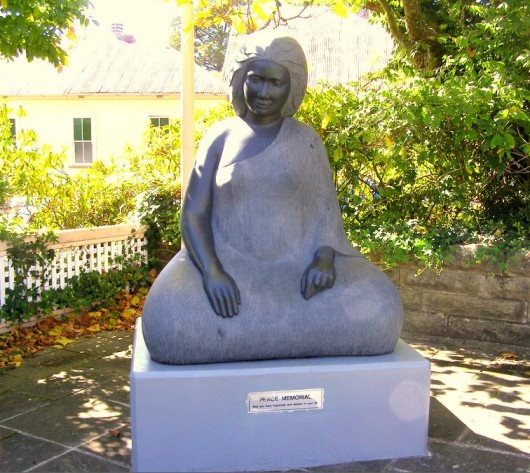 Peace Memorial
Enscription: “May you have happiness and wisdom in your life”
[by Artist, Tom Coley, who has long meditated to try to understand what peace means,
borne out of his childhood experiences during the London Blitz] Peace Memorial
Enscription: “May you have happiness and wisdom in your life”
[by Artist, Tom Coley, who has long meditated to try to understand what peace means,
borne out of his childhood experiences during the London Blitz]
.
Footnote
.
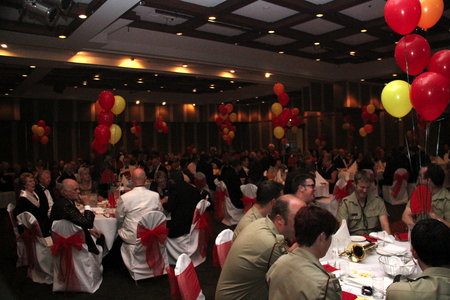 Rural Fire Service Red Balloon Ball fundraiser Rural Fire Service Red Balloon Ball fundraiser
.
April 2013:
.
<<The Blue Mountains community will receive bushfire safety messages quicker when the Blue Mountaims Rural Fires Service (RFS) implements a text messaging system and other technology, thanks to money raised at a tourism function.
About 120 industry, RFS and communty members attended the annual Blue Mountains Lithgow and Oberon Tourism (BMLOT) Red Balloon RFS Ball at the Fairmont Resort Leura on April 5.
More than $20,000 was raised through a Pick-a-Box raffle draw and a live auction with prizes including restaurant dinners, overnight stays and luxury items donated by tourism operators throughout the Blue Mountains, Lithgow and Oberon region…
Blue Mountains RFS district manager Superintendent David Jones (on government payroll) praised the 75,000 RFS volunteers throughout NSW which “serve their communities with hearts of gold”.>>
[Source: ‘Ball helps local firies’, 20130424, (RFS media release), Blue Mountains Gazette local newspaper, p.19]
.
Recall August 2012:
.
<<Australia will give Afghanistan $1 billion of aid over four years, which will be spent on rural jobs, education and developing the resource-rich nation’s mining industry.
Foreign Minister Bob Carr made the announcement at the Tokyo conference on Afghanistan attended by US Secretary of State Hillary Clinton and Afghan President Hamid Karzai.
Donors pledged a total $US16 billion ($A15.74 billion) of aid to Afghanistan over four years but called on Kabul to crack down on corruption.
Australia committed to providing around $250 million for four years from 2015/16.>>
.
[Source: ‘Australia pledges $1bn aid to Afghanistan’, 20120802, from AAP, ^http://www.theaustralian.com.au/news/breaking-news/australia-pledges-1bn-aid-to-afghanistan/story-fn3dxiwe-1226421222797]
.
[Ed: $1 billion represents nearly double the annual budget that the New South Wales Government spends on Fire and Rescue, including on the NSW Fire Brigade, on the Rural Fire Service and on the State Emergency Service. In 2012-13 the total operating budget was $647 million. Funding is simply an issue of political priorities.]
.
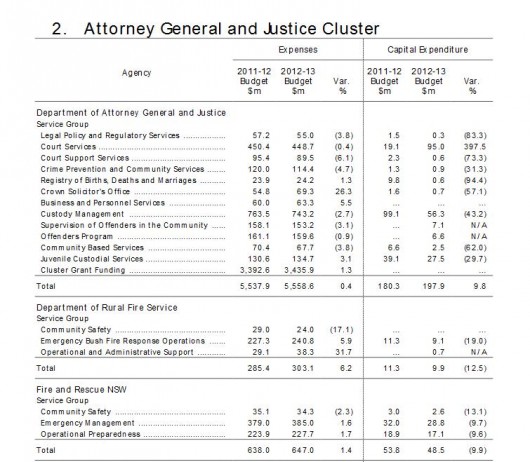 [Source: ‘Budget Paper 3, 2012-13, New South Wales Government, ^http://www.budget.nsw.gov.au/__data/assets/pdf_file/0006/18249/bp3_02attorney_and_justice.pdf] [Source: ‘Budget Paper 3, 2012-13, New South Wales Government, ^http://www.budget.nsw.gov.au/__data/assets/pdf_file/0006/18249/bp3_02attorney_and_justice.pdf]
.
Sunday, September 9th, 2012
Does wilderness still matter? Or is it just a nostalgic and overblown idea from the 1960s that has worn out its usefulness?
Unsurprisingly, the Colong Foundation for Wilderness vigorously asserts that wilderness is more important than ever. As the global environment plummets into crisis, ‘business as usual’ is rushing ever more recklessly in the opposite direction, chasing the almighty dollar. Our parks, reserves and natural areas are everywhere imperilled, by climate change, mining, tourism and many other threats. Wilderness remains a sanctuary and an insurance against the complete exploitation of nature.
Which is why the Colong Foundation has taken up the baton again for the Sixth National Wilderness Conference, established by Geoff Mosley and the Australian Conservation Foundation in 1977. The 5th and most recent conference, Celebrating Wilderness, was hosted by the Colong Foundation in 2006.
.
6th National Wilderness Conference
.
The 6th National Wilderness Conference will be held in Sydney on 21-23 September 2012 and co-presented by the NSW National Parks Association and the Nature Conservation Council of NSW.
With environmental protection laws under attack in all states and nationally, this conference comes at a critical time. So if you haven’t signed up for this conference yet, now’s the time. And don’t forget the Conference dinner, $40 for three beautiful courses at Maynard’s Café, Newtown.
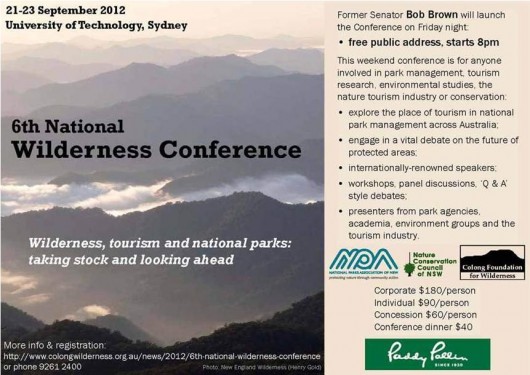
^Online Conference registration
^Program brochure and more information
Wednesday, September 5th, 2012
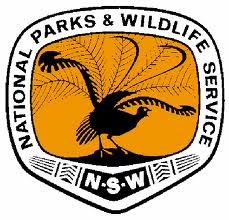 ‘National Parks’ in Australia are merely State Parks
They exist at the whim of State politicians ‘National Parks’ in Australia are merely State Parks
They exist at the whim of State politicians
.
In Australia, ‘National Parks‘ are a misnomer.
National Parks across Australia are not protected, conserved and managed by the Australian Government at national level, as the name would suggest. Instead, the custodial responsibility is delegated to the respective States.
National parks in each Australian State, such as in New South Wales, or Queensland or Tasmania, are protected, conserved and managed under that State’s national parks legislation, not under national legislation. So in Australia, the term ‘National Park‘ is quite misleading. Australians presume that our national parks are nationally protected, but they are not.
The respective ‘National Parks and Wildlife Services‘ are similarly also a misnomer. Each State and Territory has its own separate National Parks and Wildlife Service. In New South Wales (NSW), ‘national parks’ are managed by the NSW National Parks and Wildlife Service. In Tasmania, the State-controlled Parks and Wildlife Service manages national parks only in Tasmania.
In Victoria, the State-based agency is called Parks Victoria, which manages national parks in Victoria under Victorian legislation – the Parks Victoria Act 1998 and reports to the Victorian Minister for Environment and Climate Change. While in Queensland, the Queensland Parks and Wildlife Service comes under the Department of National Parks, Recreation, Sport and Racing.
When a government lumps national parks with racing, it regards the values of natural heritage in anthropocentric exploitative terms.
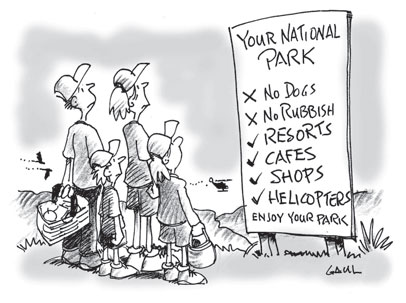 . .
Neglectful Underfunding
.
Worse is that the delegated State Government custodians are invariably so short of funding, that critical funding to properly protect, control and manage national parks is not provided. The Australian Government knows this, yet withholds vital funding so that the primary duties of protecting and conserving national parks can be fundamentally fulfilled.
State Governments select other funding priorities according to election cycles. In the 2012-13 budget year, the NSW Government has cut $55 million in recurrent funding and $22 million in capital expenditure budget in its management of national parks and to help protect native fauna. [Source: ‘NSW environment suffers $77m budget cut’, Jun 12 2012, ^http://news.ninemsn.com.au/national/8482272/nsw-environment-suffers-77m-budget-cut]
In Queensland, the State Government in 2012 has not only removed one hundred jobs from the Queensland Parks and Wildlife Service, closed regional offices, and reduced the number of QPWS regions from nine to six, but plans to revoke 875,000 hectares of national parks land across the State. [Source: ‘LNP Government: Mean To Students, Tricky On National Parks’, by Annastacia Palaszczuk, 20120719, ^http://www.queenslandlabor.org/2012/07/19/lnp-government-mean-to-students-tricky-on-national-parks/]
In Victoria in 2012, more than 130 jobs have been cut from Parks Victoria and several hundred from the Department of Sustainability and Environment (DSE). [Source: ‘Jobs and courses feel Budget strain’, by Kate Dowler, Weekly Times Now, 20120509, ^http://www.weeklytimesnow.com.au/article/2012/05/09/479741_national-news.html]
Last Easter in April 2012, some state and national parks are facing industrial action by Parks Victoria rangers belonging to the Community and Public Sector Union.
‘On the surface this may appear to be a simple wage dispute, but in fact it’s just a symptom of a larger and much more serious disease. It’s no secret that Parks Victoria is suffering from chronic underfunding. Parks and reserves across Victoria are seeing the results of decades of government cut-backs. These funding cuts affect our parks and reserves in many ways. From the supply of basic amenities (such as toilet rolls), all the way to establishing and maintaining user facilities such as walking and mountain bike trails as well as creating new management and environmental plans for the future. Looking after our public spaces is, quite simply, a massive job and if it is to be done correctly it will require substantial government funding.
Many Parks Victoria rangers do an amazing job in increasingly difficult circumstances. One of my ranger friends commented that ‘productivity improvements’ was in fact government speak for ‘saving money’. [Source: ‘Parks Victoria: Death By a Thousand Cuts’, by lenn Tempest, April 6, 2012, ^http://osp.com.au/?p=3253]
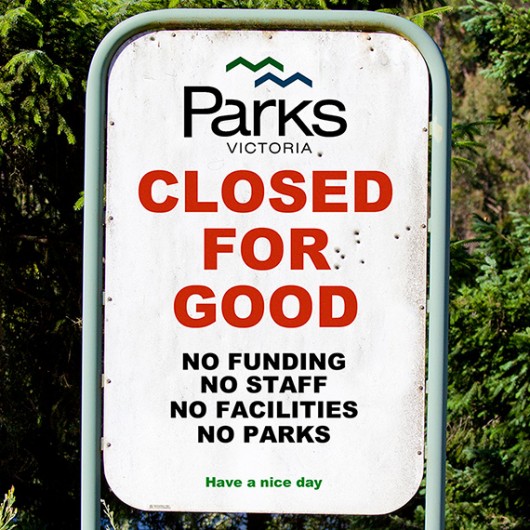
.
Belittling the National Parks Status
.
Just as bad is that the role of National Parks and Wildlife Service at each State jurisdiction has become swallowed up within mega-departmental portfolios. Australia used to have dedicated ministers for environment. Environment was their sole responsibility and national parks featured as a key part of that responsibility. But over recent decades, all the state governments have seen fit to bundle the responsibility for national parks within a large range of disparate portfolio responsibilities to one government minister.
In Tasmania, national parks responsibility falls under the responsibility of the Department of Primary Industries, Parks, Water and Environment – tagged on at the end. The current minister responsible is Brian Wightman MP, who is also Minister for Environment, Parks and Heritage (a different department name) and simultaneously Minister for Justice. How much time and energy can Wightman dedicate to national parks in his working week?
In New South Wales, the NSW National Parks and Wildlife Service (NPWS) is part of the Office of Environment and Heritage (OEH), within the NSW Department of Premier and Cabinet. The delegated minister is Robyn Parker MP who is the Minister for the Environment and the Minister for Heritage. These functions are relatively compatible, yet only a few years prior under the previous government, NPWS came under the Department of Environment, Climate Change and Water, and the various ministers responsible for varying short stints, also had other unrelated yet demanding portfolios such Commerce and Health.
In Queensland, Steven Dickson MP is responsible for National Parks, Recreation, Sport and Racing. In Victoria, Parks Victoria is lumped in with the Department of Sustainability and Environment, Catchment Management Authorities, Commissioner for Environmental Sustainability, Environment Protection Authority Victoria, Landcare Victoria, Sustainability Victoria and Zoos Victoria, which all report to Ryan Smith MP is Minister for Environment and Climate Change as well as being Minister for Youth Affairs. How many minutes does Smith give Parks Victoria in a given week?
The extreme bundling of so many responsibilities with the national parks function, effectively belittles its role.
The dilution of the national parks role is compounded by the trend of the short term assignment of a given minister to the portfolio, even within the one term of government, let alone when governments change hands. And where is the ultimate guardian for Australia’s national parks in all this – wiping its hands of responsibility and accountability for Australia’s most precious ecological assets.
Further, one can think of no minister for the environment who has ever had formal training or qualifications in environmental scence, or having been a National Parks ranger. The ultimate responsibilities for environment are delegated to politicians with little or no understanding of managing the natural environment, with all its complexities. In New South Wales the current Minister for Environment and Heritage is qualified in child day care.
.

.
World Heritage managed at State Level
.
State delegation of national parks even applies to national parks in Australia that have been listed as World Heritage Areas, like the Blue Mountains National Park, Fraser Island National Park, Great Barrier Reef National Park, Kakadu National Park, and Tasmanian Wilderness. While the Australian Government has an international obligation to protect and conserve World Heritage properties, those World Heritage properties do not become Australian Commonwealth property. State and local laws still apply. The only protection afforded to World Heritage properties is that land uses must not threaten any of the outstanding universal values of the property.
World Heritage listed properties in Australia are supposed to be managed by the Australian Government under obligations that the Australian Government signs up to under the World Heritage Convention for each listed property.
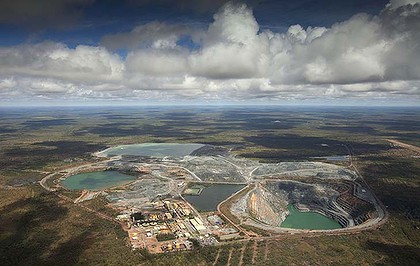 Rio Tinto’s Ranger uranium mine inside Kakadu World Heritage, Northern Territory
[Source: ‘Radioactive threat looms in Kakadu’, 20110416, by Lindsay Murdoch, Jabiru, Sydney Morning Herald,
^http://www.smh.com.au/environment/radioactive-threat-looms-in-kakadu-20110415-1dhvw.html] Rio Tinto’s Ranger uranium mine inside Kakadu World Heritage, Northern Territory
[Source: ‘Radioactive threat looms in Kakadu’, 20110416, by Lindsay Murdoch, Jabiru, Sydney Morning Herald,
^http://www.smh.com.au/environment/radioactive-threat-looms-in-kakadu-20110415-1dhvw.html]
.
The management objectives for World Heritage properties are part of Australia’s general obligations under the World Heritage Convention, which primarily includes protecting and conserving the World Heritage values of the given World Heritage property. However, the Australian Government chooses to achieve this objective by what it describes as “recognising the role of current management agencies in the protection of a property’s values” (that is by government agencies in their respective States), but also delegating custodial responsibility to the local community “in the planning and management of a World Heritage property.
In doing so, the Australian Government wipes its hands of its signed up custodial responsibility to protect and conserve Australia’s World Heritage listed properties. This is most evident with the Queensland Government currently allowing dredging in Gladstone Harbour within the Great Barrier Reef World Heritage. It is also most evident with the Tasmanian Government allowing clearfell logging adjacent to the Tasmanian Wilderness World Heritage.
The Australian Government is also liberal with its interpretation of protecting and conserving World Heritage values by what it describes as “allowing provision for use of the property which does not have a significant impact on the World Heritage values and their integrity.”
[Source: ‘Management of Australia’s world heritage listed places’, Australian Government, Department of Environment etc (currently called the Department of Sustainability, Environment, Water, Population and Community, ^http://www.environment.gov.au/heritage/about/world/managing.html]
.
‘We have become, by the power of a glorious evolutionary accident called intelligence, the stewards of life’s continuity on earth. We did not ask for this role, but we cannot abjure it. We may not be suited to it, but here we are.’
~ Steven Jay Gould, paleontologist
.
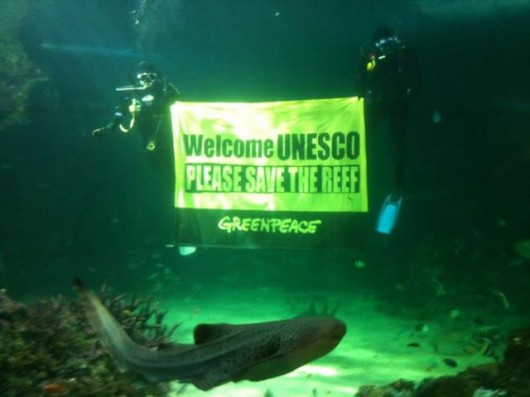 Industrialisation of the Great Barrier Reef
The dredging in Gladstone Harbour for the seam gas has been blamed by local environmentalists for the area’s poor water quality
and a skin disease affecting marine life. Green activists say dredging has adversely affected whales and dugongs in the area.
[Source: Queensland slams UNESCO, defends gas on the barrier reef Industrialisation of the Great Barrier Reef
The dredging in Gladstone Harbour for the seam gas has been blamed by local environmentalists for the area’s poor water quality
and a skin disease affecting marine life. Green activists say dredging has adversely affected whales and dugongs in the area.
[Source: Queensland slams UNESCO, defends gas on the barrier reef
Posted on June 5, 2012, ^http://rowenadelarosayoon.wordpress.com/2012/06/]
.
Tags: Australian Government, Gladstone Harbour, Great Barrier Reef World Heritage, Industrialisation of the Great Barrier Reef, Kakadu mining, national parks, National Parks and Wildlife Service, National Parks Status, World Heritage, World Heritage cons, World Heritage Convention obligations
Posted in Threats from Government Funding Neglect | 2 Comments »
Add this post to Del.icio.us - Digg
Saturday, January 28th, 2012
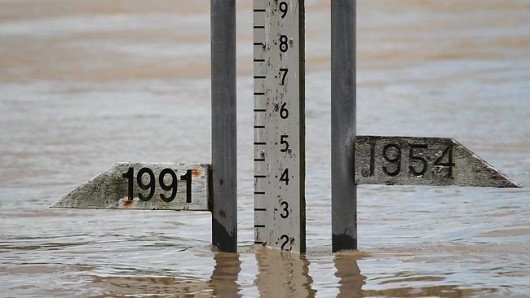 Queensland Flood Gauge – where have all the gauges gone?
Removing them is as bad as burning books – history becomes dangerously forgotten.
Put ’em back! Queensland Flood Gauge – where have all the gauges gone?
Removing them is as bad as burning books – history becomes dangerously forgotten.
Put ’em back!
.
Cyclone Yasi
.
Far North Queensland experiences a recurring pattern of tropical cyclones during the Wet Season (Cyclone Winifred in 1986, Cyclone Rona in 1999, Cyclone Larry in 2006) – some being more damaging than others. It is the luck of the draw, but should never be underestimated.
Cyclone Yasi in 2011, became severe category 5 cyclone by 1st February crossing the coast at Mission Beach bringing damaging winds of up to 290kph, torrential rain, flash flooding and 7 metre high sea storm surge.
I would not have wanted to have been there, recalling that twenty years ago in 1990 while working as a casual hotel porter, I happened to have been bunkered down in Cairns’ Four Seasons Hotel on the Esplanade, when Cyclone Joy loomed of the coast. I recall the imminent sense of the cyclone’s force warned being beyond what authorities could cope with and so everyone was genuinely frightened. The hotel’s lobby glass doors bowed inwards from the storm and I dont’ know why they didn’t break.
People that have not bunkered down in the path of an imminent cyclone cannot realise the fear of not knowing and what could happen – the prospect of death is real, people hug each other as a final gesture of humanity. As it luckily turned out, Cyclone Joy fizzled into a widespread depression causing floods across Queensland. To those at the time on the Cairns’ coast preapred to cop death, a torrential depression was nothing compared to what had been threatened. We were alive!
Luck is spiritual, and convinced of having a guardian angel, I respect Nature and so have become very conservatively minded. I once was in the Army, but I am a woos now.
Yasi delivered flooding rains inland as far as Mount Isa, Alice Springs and south into the Marray Darling basin.
The impact was mainly property and crop destruction (particularly sugar and banana), forests flattened, widespread power outage and water system failure centred around the coastal communities of Mission Beach, Tully, Silkwood, Innisfail and Cardwell. Severe flooding cut the Bruce Highway between Townsville and Ingham and many inland communities (Oodnadatta, Glendambo and Anna Creek) became isolated. One man died near Ingham.
The economic loss estimates from the storm were estimated to reach A$3.5 billion, including A$2 billion in agriculture, mining and local government, and A$1 billion in tourism.
The government response came from all three levels of government. The State’s combined emergency services were overwhelmed, so the Australian Government deployed the combined services of the Australian Defence Force under Operation Yasi Assist to aid civilian emergency response efforts with mainly transport logistics. As a precaution, the RAAF provided aeromedical evacuations for 255 patients in Cairns Base Hospital and Cairns Private Hospital ahead of the cyclone. Later emergency supplies had to be flown in to inland communities isolated by extensive flooding and many military personnel were engaged in debris removal.
The Queensland Premier, Anna Bligh, initiated the Premier’s Disaster Relief Appeal which ended up raising $281 million from inside the Australian community and from overseas donors. St. Vincent de Paul received $23 million which providing funds to over 2,464 affected households.
The Queensland Reconstruction Authority was established to develop, implement and manage a state wide plan for rebuilding and reconnecting communities affected by the floods and cyclones. The restoration and recovery cost were estimated at $800 million, mainly to rebuild road and transport infrastructure. This cost was borne 25% by the Queensland Givernment,and 75% by Australian Government.
Under the Australian Government’s dedicated Disaster Assist programme outlays for some 273,942 claims amounted to $310 million.
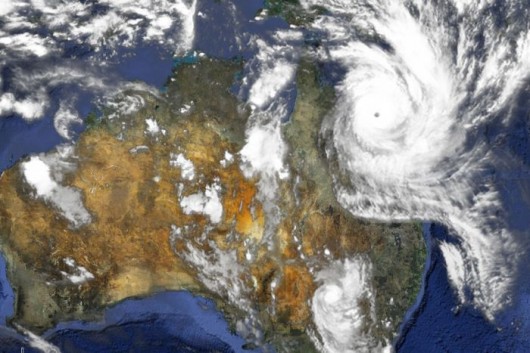 Northern Australia’s annual cyclone season – seen this before; nothing new Northern Australia’s annual cyclone season – seen this before; nothing new
.
Queensland Floods
.
Over the summer of 2010-11, a series of torrential rain storms likely associated with the La Niña climate pattern over the Pacific as well as record-high ocean temperatures in the north-eastern Indian Ocean.
This climate pattern, alternating between the high risk flooding of La Niña and the prolonged droughts of El Niño is a well established weather pattern affecting particularly northern Australia.
The Queensland Floods of 2011 affected the Fitzroy, Burnett, Condamine, Ballone, Mary, Brisbane and Bremer Rivers as well as Lockyer Creek and Oakey Creek (Toowoomba). An unexpected flash flood raced through Toowoomba’s central business district. Water from the same storm devastated communities in the Lockyer Valley. A few days later thousands of houses in Ipswich and Brisbane were inundated as the Brisbane River rose and Wivenhoe Dam used a considerable proportion of its flood mitigation capacity.
More than 70 towns were flooded, forcing evacuation of over 200,000 people. Much of central and southern Queensland including Brisbane, Rockhampton, Emerald, Bundaberg, Dalby, Toowoomba, and Ipswich were inundated. More than 5900 insured homes were inundated in Brisbane and Ipswich when rivers erupted on 12th and 13th January 2011. Three-quarters of the state of Queensland was declared a disaster zone. There were 35 people confirmed dead and 9 missing. The damages bill was A$30 billion.
A large mobilisation of the Australian Defence Force was activated and a relief fund created. The head of the recovery taskforce was Major General Michael Slater, DSC, AM, CSC. The Queensland Reconstruction Authority was formed to co-ordinate the rebuilding program beyond the initial taskforce and a Commission of Inquiry established to investigate all matters related to the floods.
In figures released at the end of January 2011, the Insurance Council of Australia calculated that 38,460 individual claims were lodged with insurers which were worth A$1.51 billion. Nearly half of those claims were for damage to homes and more than half were made by those living in Brisbane.
With much of Queensland’s agriculture destroyed, the price of food across Australia rose, particularly fruits and vegetables and coal production slowed due to coal railway lines were closed and numerous mine sites being flooded. The Australian Government is estimating an ultimate bill of $5.6 billion.
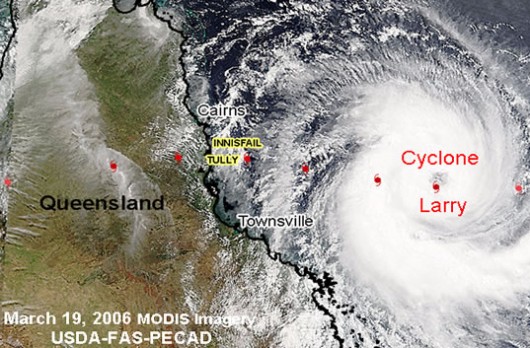 Australia’s recurring history of cyclones Australia’s recurring history of cyclones
.
- 1899 – CYCLONE MAHINA (Category 5)
- 1918 – CYCLONE MACKAY (Category 4)
- 1918 – CYCLONE INNISFAIL (Category 5)
- 1970 – CYCLONE ADA (Category 4)
- 1971 – CYCLONE ALTHEA (Category 4)
- 1972 – CYCLONE EMILY (Category 2)
- 1974 – CYCLONE TRACY (Category 4)
- 1975 – CYCLONE JOAN (Category 5)
- 1978 – CYCLONE ALBY (Category 4)
- 1986 – CYCLONE WINIFRED (Category 3)
- 1989 – CYCLONE ORSON (Category 4)
- 1995 – CYCLONE BOBBY (Category 4)
- 1997 – CYCLONE JUSTIN (Category 3)
- 2005 – CYCLONE INGRID (Category 4/5)
- 2006 – CYCLONE LARRY (Category 4)
- 2006 – Cyclone Larry (Category 4)
- 2007 – CYCLONE GEORGE (Category 5)
- 2011 – CYCLONE YASI (Category 5)
.
Notice any trend? They tend to come in La Niña waves.
.
Indirect Causes of the 2010-11 Queensland Floods
.
1. Category 5 Cyclone Yasi – cyclones are a frequent occurrence in Far North Queensland during the Wet (November to March)
2. The known prevailing La Niña climate pattern affecting Australia generally, worsening with known trends in climate change
3. Widespread torrential rain storms causing localised flooding
4. The creating and design of artificial storage dams on major rivers altering the natural river flows – Wivenhoe Dam on the Brisbane River
5. Deforestation denying tree transpiration to take up much of the surface water, exacerbating surface runoff causing flooding of rivers and creeks regionally
6. Human population settlements situated in known flood-prone land, encouraged by urban planning, land use development and housing approvals, thus with heightened exposure to periodic storm flood. Why were areas developed when people knew it was flood-prone? What planning laws were ignored by Local and State governments to allow housing approvals in low-lying areas prone to flood and storm surge, indeed withaq recurring history of flooding? The CSIRO has found that 32,500 homes in Queensland’s thickly settled southeast are exposed to a 2.5m storm tide, risking damage of $1.1 billion – by the time today’s babies leave school, in 2030, the number of homes at risk will be 61,500, at a potential cost of of $2bn in today’s dollars. Local and State governments have forgotten about flooding and permitted too much development in danger zones on the sea front and in flood plains.
7. Human population settlements situated in known sea surge -prone land, encouraged by urban planning, land use development and housing approvals, , thus with heightened exposure to periodic storm flood. It is not as if Brisbane has no precedent for flood – look at 1893 and 1974!
8. Local government land use development legislation allowing and facilitating building on flood-prone land
9. Greedy developers profiting from property sales and development on land having a known recurring record of storm flood and surge risk
10. Local, State and National governments turning a blind eye to mitigate the impacts of recurring storms in known areas that have and continue to cause flooding, damaging winds and coastal inundation.
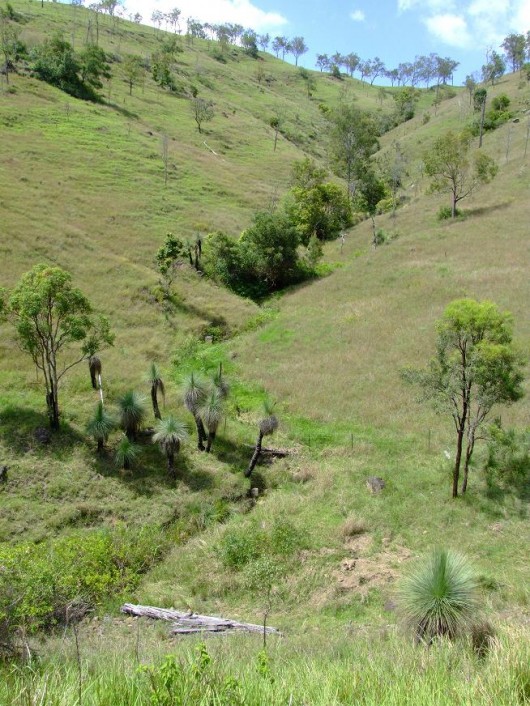 Widespread deforestation of riverine valleys including their steep upper reaches
removes vital native forest cover denying natural transpiration
and so exacerbates local surface runoff and consequential regional flash flooding Widespread deforestation of riverine valleys including their steep upper reaches
removes vital native forest cover denying natural transpiration
and so exacerbates local surface runoff and consequential regional flash flooding
.
Direct and Culpable Causes of the Queensland Floods Impact
.
1. The delayed timing of the water overflow release from Wivenhoe Dam that directly caused the Brisbane River flooding
2. State government failure to assess the effectiveness of home and contents insurance coverage of property owners located in known flood prone and storm surge areas and failure to proactively address the shortcomings of this risk ahead of such disasters. The Insurance Council has estimated the damage from flooding and cyclones in Queensland amounts to $2 billion — modelling emerged to show how vulnerable the country is to extreme weather.
3. Local, State and National governments failure to undertake adequate risk assessment for disaster management, especially in areas having a recurring history of cyclones, torrential rains, riverine flooding, flash floods, storm surges and coastal inundation. Where is Queensland’s, indeed Northern Australia’s disaster preparedness and resilience plan? It needs to factor in all the Dorothea MacKeller terror scenarios.
4. Failure by the Queensland Government to utilise the Brisbane River’s Wivenhoe Dam for its intended purpose – flood mitigation, not water storage
5. Operational failure by the Queensland Government to release water ahead of know heavy rain period during the known high risk La Niña climate pattern in the height of summer at a time of ongoing torrential rains
6. Failure to listen to prior warning from the Australian Bureau of Meteorology about the heightened risk from La Niña and for State, Local and National Governements to prepare and respond accordingly
7. Failure by State and National governments to provide appropriate infrastructure situated and designed to withstand flash flooding events, storm surges and damaging winds. Power lines are still placed above ground making critical power supply susceptible to damaging winds causing widespread power outages. Why are critical facilities such as public hospitals and evacuation/emergency relief centres not located safely beyond the effects of flood, and storm surges and coastal inundation?
8. Failure by State and National governments to provide for emergency contingency and a sufficiently resources response. Natural disasters such as torrential flooding rain and cyclones are not preventable but in Queensland are a know recurrence. Their impact and cost is compounded by poor planning decisions and unheeded warnings. Queensland’s disaster contingency preparation is woeful.Emergency services were stretched to the limit nationally, hence the Australian Defence Force was called in – a desperate last resort. The Australian Defence Force is primarily trained, equipped and prepared for military emergencies, not civil emergencies such as natural disasters, so the response was suboptimal. What is the capacity, training and state of readiness of Defence Forces to cope with civil disasters at home, let alone in our region?
9. Recurring failure by local, State and national governments to collectively learn from past natural disasters, to adopt and implement the recommendations from previous reports and enquiries into natural disasters across Queensland, and to consider and implement world’s best practice solutions.
10. Recurring failure by local, State and national governments to accordingly budget for and to allocate sufficient capital and recurrent funding to ensure timely outcomes
11. Greedy insurance companies denying claims payments because of discretionary interpretation of home and contents insurance clauses.
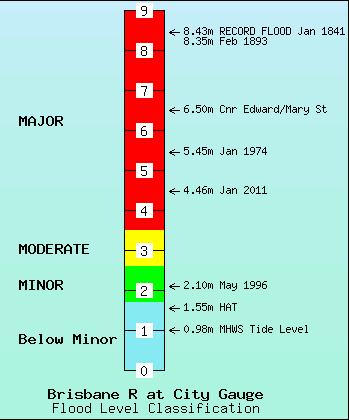 Brisbane River Flood History Brisbane River Flood History
.
Government Responsibility
.
What do we vote in and pay our politicians for? Is it to represent our collective interests, deliver on election promises and to get done the job of government or is it speech writing and popularism?
The incumbent US President Barack Obama rode to power in 2008 on the basis of good speech writing and delivery and on the back of an incompetent, dysfunction Bush Government embroiled in warmongering on false pretences and corrupt involvement by Halliburton, $300 billion in Defence excesses, a failed health care system, a $455 billion deficit, a widened wealth gap and condoning torture at Guantanimo. Arguably at the time, Obama piggybacked on the popular mandate for change when almost anyone was going to better than the Republicans arrogant clown from Texas, George W.
Obama in his speeches to win office inspired and promised. On the night before the 2008 presidential election on 3rd November 2008, Obama declared:
“I come away with an unyielding belief that if we only had a government as responsible as all of you, as compassionate as the American people, that there is no obstacle that we can’t overcome. There is no destiny that we cannot fulfill.” “Tomorrow you can choose policies that invest in our middle class, create new jobs and grow this economy so that everybody has a chance to succeed.”
.
Then he went full-blown American, ranting on about “this defining moment in history“, “this is where change begins“, “the men and women who serve on our battlefields..(who) fought together and they bled together…some die together under the same proud flag, “yes we can“, blah, blah, blah.
Four years later in 2012, Obamba’s policies have added $1.4 trillion to US national debt, the U.S. credit rating has been downgraded to AA+, unemployment is still over 8%, the US strategic war in Afghanistan is still going, healthcare is still unaffordable to most Americans, and Gitmo is still open for business. Obama has spent a record $12.8 trillion bailing out failed banks, mortgage lenders and car manufacturers. To a degree, the Republican Party’s ‘no we won’t‘ party political recalcitrance, stymieing US Congress decision making, has stiffled Obama’s ‘yes we can‘ delivery. The politics is stifling the country.
.
Back in Australia, at the height of the combined calamities afflicting Queensland by Cyclone Yasi, regional flooding and the Brisbane River flood; on 13th January 2011 Labor Premier Anna Bligh gave a short media conference, now famously referred to as her ‘We are Queenslanders‘ speech.
“As we weep for what we have lost, and as we grieve for family and friends and we confront the challenge that is before us, I want us to remember who we are,” she said. “We are Queenslanders. We are the people they breed tough north of the border. We’re the ones that they knock down, and we get up again.
“I said earlier this week that this weather may break our hearts, and it is doing that. But it will not break our will. And in the coming weeks and the coming months we are going prove that beyond any doubt. Together we can pull through this, and with your help, we can achieve it.”
[Source: ‘Blighs tearfilled cry we are queenslanders’, by Megan Levy, 20110113, ^http://www.brisbanetimes.com.au/environment/weather/blighs-tearfilled-cry-we-are-queenslanders-20110113-19oxt.html]
.
Spare us!
In such crises, people look to their government for leadership, security and resources. At other times, people have a right to expect that their government will responsibly assess risks and prepare for contingencies in the event of crises. This necessarily involves appropriate contingency planning, infrastructure provision and resourcing of emergency management. It also involves appropriate and timely emergency response followed by recovery and rebuilding. It also requires learning lessons and implementing appropriate measures to mitigate the impact of future crises. In Queensland’s case three are three levels of government and in 2011 both State and Federal Government were Labor.
Beyond stirring speeches how has the Bligh Government performed its duty as government?
[Source: ‘Summer of fury exposes planning failures‘ by Jamie Walker, Natasha Bita, Jared Owens, The Australian, 20110212, ^http://www.theaustralian.com.au/news/nation/summer-of-fury-exposes-planning-failures/story-e6frg6nf-1226004691620]
.
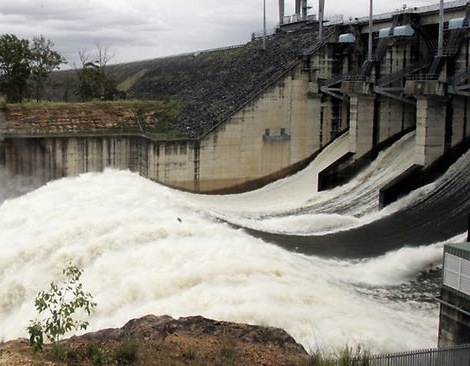 We are Queenslanders – we opened the flood gates at the wrong time – sorry. We are Queenslanders – we opened the flood gates at the wrong time – sorry.
.
Tags: Brisbane River flooding, Causes of the Queensland Floods, Cyclone Yasi, Government Responsibility for flooding, La Niña, Queensland Floods, We are Queenslanders Speech, Wet Season, Widespread deforestation, Wivenhoe Dam flood gates
Posted in Threats from Development, Threats from Government Funding Neglect, Threats from Government Mismanagement, Threats from Stormwater Runoff | No Comments »
Add this post to Del.icio.us - Digg
|
|



